| MY RESEARCH QUESTION How can widening participation students from the CSM Insights programme be better supported by the BA staff team and receive a more inclusive educational experience by being more prepared and equipped when entering BA courses so that we achieve social justice through a higher attainment and retention rate from this student demographic ? PROJECT FOCUS My plan is for creating a sense of student belonging and improve attainment levels from students from widening participation backgrounds by researching and creating a study for how there could be a possibility to improve the retention of students on the BA Fashion pathways, specifically from students who are recruited from the CSM Insights programme route. Through a series of questionnaires and interviews, I will create a study to ascertain the need for additional support through a proposal for supporting the existing Insights teaching programme and developing through tuition and information sessions, connections between the BA tutor team and the Insights student cohort before they commence BA studies. I also plan to use the data gathered from learning about student experience to consider the need for creating a safe space mentorship student support group. I am focussing my study in particular on the CSM Insights programme. Through this research project, my personal motivations are to aid my personal and professional development in my role as an educator and creative researcher. I aim to use this project to discover a greater understanding of how I can utilise my role to embed social justice into my teaching methods and create stronger support for students from widening participation backgrounds. From my experience as Pathway Leader, BA Fashion Design:Communication, I have reflected on the existing barriers and difficulties students face from contextual admissions and widening participation backgrounds experience when entering the BA course and this can lead to students experiencing feelings of despair and being overwhelmed and out of their depth, which has led to students deciding to defer, take planned time out or in some cases even withdraw from their the courses. From my own life experience coming from a widening participation low income background, where there were few expectations of me being able to fulfil any of life’s dreams and aspirations, I can fully reflect on this particular area of study and understand how my personal circumstances have shaped my ambitions in my teaching practice and my desire to create an inclusive, enriching learning experience for students from all backgrounds and diverse life experiences to create a fully inclusive environment where everyone is able to flourish regardless of background or their personal circumstances. As well as my role of fashion design tutor and pathway leader, I have worked on the CSM Insights programme for several years focussing on widening participation and the creative empowerment of young people from more lower income backgrounds and from minority groups to enable them to achieve their aspirations and move into Higher Education. During this experience I have worked with students who are confronted by many barriers and can also have wide ranging learning disabilities which can create issues in fully engaging in the learning process when entering Higher Education programmes and courses. Students disabilities are often non physical and non visible and can often be more neuro diverse such as ADHD, dyspraxia, autism, dyslexia and this is combined with the intersections of complex combinations of personal commitments from their circumstances, such as caring for family members and the many constraints created by socio economic restrictions. From my own personal point of view, I am from a low income family background, from the North of England, the first in my family to go to university and I am a single parent, so my own intersectionality and positionality has some close connections to some of the Insights students backgrounds, which enables me to understand through my own lived experience, the complex barriers and constraints that can hold people back from self belief in the possibility of becoming a high achiever. Students joining the BA Fashion course who are a from a Contextual admissions route, from widening participation who are from the UAL Insights programme can often feel overwhelmed and out of place when they start on BA Fashion courses at CSM. There are a marked number of students from this entry point, in my experience who achieve low grades, fail or do not submit project work, and this can lead to them leaving the course in first year or needing to repeat the 1st year or take planned time out, due to feelings of not belonging in a high achieving competitive environment and not being able to cope with the workload or being prepared for the levels of expectations. Students often feel unable to cope and lack confident in their skills to keep on track with the course and because of this, they find it difficult to feel that they have a right to be there, or that they don’t have equivalent talent and skills to match other students on the course who have more confidence due to experiencing a more privileged educational background and more access to art and design in the form of short courses and private tuition. My research will analyse and evaluate opinions from staff and students to understand how support could be implemented within our curriculum and what the areas of limitations are. I aim to understand through researching into the barriers that currently exist, how the fashion programme at Central Saint Martins can be more supportive of widening participation students. I will be interviewing staff members and asking students to complete feedback from a series of targeted questions that I have created in a document format. MY PLAN IS TO 1.Conduct research to support this study from a selection of staff and student participants through targeted questionnaires and interviews to collect data to analyse the current barriers and issues and find out about how relevant support can be implemented. 2. Design an outline for a proposal for a support system that is aimed at supporting CSM Insights students before commencing the BA course and propose a series of talks and tuition sessions to help with navigating some key areas that students cover when beginning BA studies, such as researching in the library, concept building, design development processes, drawing, 3D technical and presentation skills. 3.Research into student experience and opinion and create a planned proposal for a peer/mentorship student support group which would be accessible to the widening participant cohort throughout the department to create supportive connections and a safe space to discuss any issues or ask for help and advice. 4. Consider how this can be a model for other courses at UAL outside of BA Fashion. |
POSITIONALITY
From my experience as Pathway Leader, BA Fashion Design:Communication, I have reflected on the difficulties and barriers students from contextual admissions and widening participation backgrounds experience when entering the BA course and this can lead to students experiencing feelings of despair and being overwhelmed and out of their depth. This has led to students specifically from these backgrounds sometimes deciding to defer, take planned time out or in some cases even withdraw from their the courses.
From my own life experience coming from a low income, widening participation background, from a deprived area in the North of England where I had to face economic barriers and constantly challenge the impositions placed on me of low expectations and aspirations on my desired achievement levels, so I can fully reflect on the social justice aspects and understand how my personal circumstances have shaped my teaching practice and my desire to create an enriching and inclusivelearning experience for students from all backgrounds and diverse life experiences to create a fully inclusive environment where everyone is able to flourish.
In particular my aims are to research how to implement more social justice into the BA Fashion programme by creating a study that analysesspecific areas of support that can be integrated within the CSM Insights programme.
As a white British woman working within fashion design academia, with English as a first language, I am aware that my position is one of privilege, and I’m considered part of a majority demographic of staff at University of the Arts London.
Throughout the PG Cert course, I’ve aimed to confront and re-evaluate my social biases, encourage open conversations around diversity and inclusion within my teaching practice, and implement diverse and radical pedagogy into the course content, project focus within the boundaries of the educational curriculum.
RATIONALE
My research into this study will create an inclusive space for analysis and evaluate how students from widening participation backgrounds experience the transition onto BA Fashion and to provide information about what additional support would create a more inclusive learning experience and bring more social justice within the curriculum.
My positionality being from a low income, widening participation background has created a specific interest in this area of study that is highly personal to me and something that I feel I can offer real and meaningful support from a position of authenticity, knowledge and lived experience.
By understanding what barriers students experience, I can create a study for how to embed social justice and actively support student learning and challenge the contributing factors that can be an influential factor in lower attainment levels and aim to improve the retention of students.
From the staff point of view, I will be asking targeted questions regarding their experiences teaching widening participation students from the Insights programme,
interviewing staff members and asking students to complete feedback on a series of questions related to their experience.
Through this research project, I hope to uplift my personal and professional development and create actions dedicated to social justice in my role as an educator and creative practitioner.
ETHICAL ACTION PLAN
ETHICS
Consent form
I have created a participant information sheet outlining the project focus and a consent form for each participant to sign to give consent to their comments being used for information and evaluation.
APPROACH
STAFF QUESTIONNAIRES
Provide BA fashion staff who are teaching students who have studied on the the CSM Insights programme, with a questionnaire which requests information regarding the student experience, retention and attainment on the BA Fashion course at CSM.
STAFF INTERVIEWS
Conduct interviews to create a focussed study through targeted questions with staff members from the BA fashion programme at Central Saint Martins and also from a representative from the CSM Insights programme to gather relevant data from their perspective.
STUDENT QUESTIOINNAIRES
Provide BA fashion students who are from the CSM Insights programme with a questionnaire which requests information regarding their experience transitioning on to the BA Fashion course at CSM.
QUANTATIVE
Analyse staff interviewee responses, from a diverse selection of interviewees and collect interview response data, through targeted questionnaires and face to face interviews.
QUALITATIVE
To assess the responses collected from staff questionnaires and interviews through close analysis, by comparing and contrasting responses and that inform the factors that create barriers for fashion design students in higher education.
An information sheet about the project and a consent form outlining ethical practices and ensuring anonymity and confidentiality are provided with the questionnaires.
PARTICIPANT FACING DOCUMENTS
I have written an INFORMATION FORM for participants to understand the project focus
ACTION RESEARCH PROJECT :
Creating a study to research about the need for a Support System for Widening Participation students on the Insights programme.
PARTICIPANT INFORMATION SHEET
ABOUT THIS STUDY
This study is part of my research on the PgCert Academic Practice in Art, Design and Communication at UAL.
I am conducting an enquiry into how students from the CSM Insights programme and from Widening Participation find the course expectations and workload on the BA course and I am researching about how to create a system of targeted support workshops pre- BA studies and the need for instigating a peer support groups that last throughout the course.
I feel that by sharing this information, we can collectively create a better and more inclusive system to improve social justice, student experience and learning opportunities.
The methodology will be both quantitative and qualitative, taking a responsive evaluation approach. This will consist of interviews with staff members and questionnaires with students. Responses will be transcribed and analysed anonymously.
What does it mean to take part?
If you take part, you are consenting to taking part by recording your feedback directly on a question and answer page.
The data will be used as the basis for academic analysis.
If you choose to take part, you will be free to withdraw your participation at any point. You will not be obliged to give any reason for deciding not to take part.
Will my participation be kept confidential?
Your anonymity is very important. The information about you will be confidential to me, as the researcher. You will not be identified individually anywhere in the research. If I quote anything you have said in an interview, it will be anonymous. An example might be: ‘Tutor A said ‘The project is.
What will happen to the results of the research project?
Analysis from the information – including anonymous quotations from you, will contribute to an academic dissertation. Your answers may also be quoted in the final presentation to a closed group of Pg Cert students and staff and may be included in my academic Pg Cert blog.
These may appear online, but will not include any names or detailed job descriptions.
Thank you for your contribution and participation in this study.
Contact for further information:
Contact
Investigator: Stephanie Cooper, Central Saint Martins, 1 Granary Square, London,
I have written a questionnaire for student participants and another one for tutor participants. The data will be collected from written answers and also in person interviews.
I have also written a separate questionnaire for the Insights team who work with widening participation students and can offer unique perspectives into the barriers students on the programme can face while participating in the regular tuition sessions.
Student questionnaire
STUDENT QUESTIONNAIRE
Student 1
1. Can you tell me how you found the transition to BA from your previous course
Transitioning to fashion design felt very natural, as coming up with concepts, world-building, designing and making came very easy to me and it’s also something I enjoy very much. However, as I previously didn’t study fashion nor had technical training in pattern cutting, I struggled to pick up that element of fashion.
2. What issues you faced in your first year
In the first year I was expected to be at the same standards as other students who had previously studied fashion or had intensive training prior to starting the BA course. Instead of being helped with my personal development and my journey in fashion, I was constantly compared to other students in a negative way. During tutorials, if my research, for example, was not the standard of what other students were doing, I was sort of ignored immediately and told to use academic support rather than get direct help during my timetabled tutorials. There was also a lack of constructive criticism that existed in the first year.
I am usually very confident within myself, therefore that experience during the first year made me disappointed, but it didn’t have an effect on me as a student and as a designer. Having confidence in myself, as well as knowing my strengths and weaknesses allowed me to persevere and focus on my studies.
For instance, during the Reset project I felt I received very little support especially with pattern cutting. I remember I received the Reset show fabric one day before the crit. I was expected to create a full artisanal look in such a short amount of time. Also, there were other issues such as lack of support in terms of pattern cutting. I remember being helped to alter a pattern for one of the pieces only for it to end up being wrong once I started working on it. When I decided to ask for support to fix the issue I was ignored. Despite all the issues, I had so much fun doing what I love and created an outcome I was very happy and satisfied with.
3A. If you felt you needed more support.
Yes. I felt I needed advice and guidance on how to improve my research skills in the first year, so I could be ready for the second year. I remember in my first year I asked how I could improve my research skills and I was told to figure it out myself, so some practical workshop in research to support me before beginning the BA course would have helped me to be able to be more self reliant and motivated in this area.
3B. In what form would this support ideally take to help you progress and flourish in your studies.
I am very happy with second year as I have been improving at a rapid rate due to the support and advice I have been receiving. Every time I would receive constructive criticism during tutorials or crits, I find myself immediately actioning it and finding a way to improve. Since starting my second year I found myself super excited to work on my projects and investing time working on my weaknesses as well as enhancing my strengths.
Student 2
1. Can you tell me how you found the transition to BA from your previous course
I found the transition difficult at first, I think compared to students who had done courses at CSM prior to BA Fashion such as Foundation in Art and Design, short courses or Fashion Folio, they were more familiar with the self-directed way of teaching and what to expect in end of project critiques and were more confident discussing their work in front of a group.
2. What issues you faced in your first year
At the time of starting the BA course, I was one of few home students from a working class background and also I was 1 out of 2 black students in my class. With this came issues of not always being able to relate to my peers, this can feel isolating as you try to fit in, I felt unsure. How to integrate into other social groups.
Also at first, acknowledging that I was not able to buy expensive fabric or pay for an. Outside seamstress like some of my classmates made me feel at a disadvantage.
3A If you felt you needed more support.
Yes. I definitely would have benefitted from more support, once I began the course.
3B. In what form would this support ideally take to help you progress and flourish in your studies.
Whether it was more support tutorials or the running of a course prior to starting the BA, for example helping with how to do your Summer project before starting the course so you get a better idea of what to expect and have experience in presenting and talking about my work in front of a group of people.
Also having a network of Insights students or mentors of different years giving advice/support before commencing the course and especially in the. First few weeks, or even just having more support of. How to use the facilities CSM to discover its full potential.
Student 3
1. Can you tell me how you found the transition to BA from your previous course
At first I was overwhelmed and hesitant, especially because of the other people on the course and the expectations of the work load set. It was like learning a new language to understand how everything worked on BA, as I didn’t really have examples of work expectancy or any mentors that were on board who had already completed their first year who I could talk to and ask questions.
2. What issues you faced in your first year
I didn’t know I had access to most of the university facilities in the beginning because I wasn’t made aware, and I wish I took advantage and had usage of everything available to me during first year. So, really emphasising on the facilities that CSM offers and doing more experimental workshops before commencing BA would’ve been very useful for Insights students like me.
3. If you felt you needed more support
Yes. It would have been more welcoming if there were additional support sessions before the BA course or support meetings I could attend, to get out of my comfort zone and talk to more people and understand the expectancy of the course. Perhaps see more examples, see what opportunities and examples of creativity and what was possible.
3B.In what form would this additional support ideally take to help you progress and flourish in your studies.
I feel like because I was very hesitant and shy in talking to different tutors and students, having more classes and workshops as a whole support structure before the beginning of the year would have brought a confident boost to a new Insights student, pushing them into talking to others on the same course/tutors as them. Building a strong relationship from an early age.
Student 4
1. Can you tell me how you found the transition to BA from your previous course.
The transition from a foundation course to a BA was definitely challenging. There were moments when I found myself in positions of self-doubt, questioning my abilities and decisions. During my previous course, I was supported by tutors who encouraged me to explore my options and gave me the confidence to make choices about my BA. However, stepping into the new program, I found myself doubting whether I had made the right decision.
Despite the challenges, that initial support from my tutors was essential in guiding me to where I am now. It’s been a journey of navigating new expectations and managing self-doubt, but I’m learning to lean on my strengths and trust in the growth that comes with taking on something new.
2.What barriers did you face in your first year of study
In my first year of study, I faced a few key barriers. One of the biggest challenges was managing self-doubt, especially in a new environment with higher expectations. Transitioning from a foundation course to a BA meant adapting to a more specialised and intense workload, which sometimes left me questioning my abilities and choices.
Another barrier was adjusting to the level of independence expected at this level. While I had support, there was a greater emphasis on self-directed study and initiative, which was a shift from the structured guidance I was used to. Balancing this independence with the need for reassurance was difficult at times.
Additionally, I struggled with not yet feeling confident in some of the technical aspects, such as research, development, and pattern cutting. I am still working on understanding the full process for these skills and incorporating them effectively into my projects. Not being entirely sure of these fundamentals sometimes made it hard to feel fully engaged in my creative process.
Lastly, time management became a hurdle as the workload increased and the projects became more complex. Learning to juggle multiple projects, research, and deadlines while still developing my skills and creative ideas took time and patience.
3A. Did you feel that you needed more support outside of the existing available resources on the Insights course and when you were first on the BA course?
Yes, I did feel the need for additional support outside of the resources available in both the Insights course and when I first started the BA. Developing a cohesive portfolio that showcased a range of techniques and processes was a key goal for me, but I realised that the existing resources weren’t always enough to meet this ambition.
To achieve the level of detail and refinement I wanted, I found it necessary to seek out additional resources beyond what was offered. This included exploring external workshops, tutorials, and other learning materials to deepen my understanding of techniques that I could then integrate into my portfolio. These outside resources helped me to produce work that was more technically sound and conceptually cohesive, which was essential in building a portfolio that reflected my capabilities and vision.
During the BA course, not having that extra support slowed me down, as I still struggle with the process of developing ideas and then translating them into garments. Without access to additional guidance and resources, I found it challenging to bridge the gap between concept development and the technical skills needed to bring those ideas to life. This made it harder to create a portfolio that reflected my full potential, as I was often caught up in trying to navigate the process on my own.
3B.In what form would this additional support ideally take to help you progress and flourish in your studies.
Technical skill workshops. Dedicated sessions focused on specific techniques like draping, fabric manipulation, or garment finishing would allow me to practice and master these skills under guided supervision. Having access to experts from the BA who could demonstrate and troubleshoot complex techniques would be incredibly helpful.
Research and Development Workshops: Workshops that focus on structuring the research and development phase of a project could have helped me feel more confident in that area. These could include activities like brainstorming sessions, sketching, mood boards, and translating ideas into initial designs, which would help me bridge the gap between concept and execution.
Visits to art and design exhibitions would give me a better understanding about research.
Observing real-world applications of design and construction methods would bridge the gap between what I’m learning and how it applies.
KEY EXAMPLES : STUDENTS
Student 1
I felt I needed advice and guidance on how to improve my research skills in the first year, so I could be ready for the second year. I remember in my first year I asked how I could improve my research skills and I was told to figure it out myself, so some practical workshop in research to support me before beginning the BA course would have helped me to be able to be more self reliant and motivated in this area.
Student 2
Whether it was more support tutorials or the running of a course prior to starting the BA, for example helping with how to do your Summer project before starting the course so you get a better idea of what to expect and have experience in presenting and talking about my work in front of a group of people. Also having a network of Insights students or mentors of different years giving advice/support before commencing the course and especially in the. First few weeks, or even just having more support of. How to use the facilities CSM to discover its full potential.
Student 3
It would have been more welcoming if there were additional support sessions before the BA course or support meetings I could attend, to get out of my comfort zone and talk to more people and understand the expectancy of the course. Perhaps see more examples, see what opportunities and examples of creativity and what was possible.
Student 4
I struggled with not yet feeling confident in some of the technical aspects, such as research, development, and pattern cutting. I am still working on understanding the full process for these skills and incorporating them effectively into my projects. Not being entirely sure of these fundamentals sometimes made it hard to feel fully engaged in my creative process. Having access to experts from the BA who could demonstrate and troubleshoot complex techniques would have been incredibly helpful.
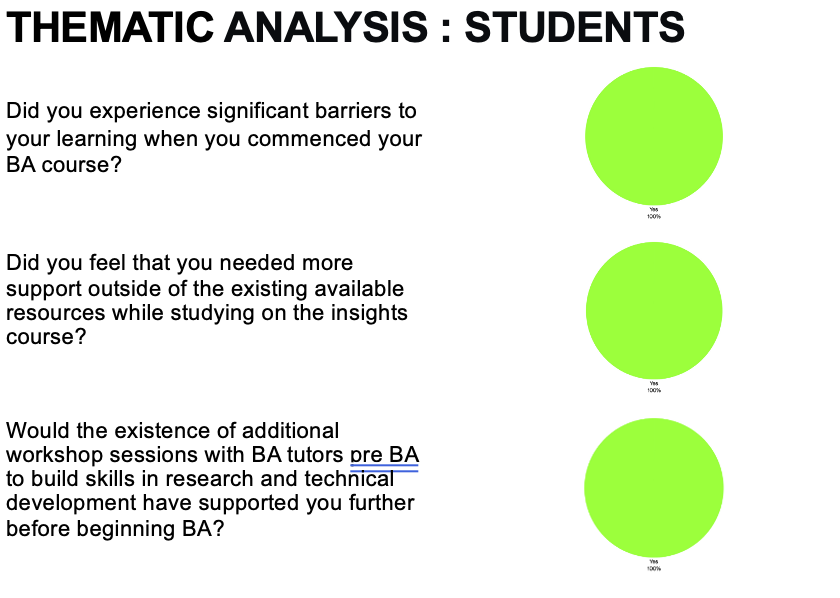
Tutor questionnaire
I have also interviewed one of the Insights core support team to find out about any barriers students face pre BA and what additional help could be offered to create more of a community between Insights and the BA courses.
ACTION RESEARCH PROJECT
TUTOR QUESTIONNAIRE
TUTOR 1
1. In your experience, do you find that students from the Contextual Admissions/ Insights programme route and Widening Participation backgrounds experience specific barriers when beginning the BA course?
Yes. When recruiting contextual admissions students we are more likely to take a risk on a student who shows promise. Sometimes their core skills of drawing are not as strong as students who have been supported with additional tutoring.
The course can cost students money to buy materials and print , which means if they can’t afford what they want they are forced to make compromises
If they have to work to be able to afford their rent in London they are likely to miss time that other students can spend developing their projects .
2. What key barriers do you believe students from the specified admissions route face when navigating the BA course?
Finances which can impact many areas of their work and ability to progress.
Time is also an issue when having to work to cover basic costs
3. Do you find that they are less likely to seek support and admit they are finding the course difficult ?
I think although we try and persuade them to seek support, they often do not follow it up and it takes a few prompts to get them there.
4. In what form do you think support could be given?
In an ideal scenario
Contextual admissions students should have full scholarships so that they are not impeded by a lack of money to pay rent and study they need additional drawing lessons , life drawing for fashion design and fashion illustration , to help communicate their ideas more clearly. Free adobe suite ,
5. In your experience, have students from the specified admission routes withdrawn from the course, requested time out or had to repeat units due to
Yes, this has happened with non submissions and not passing projects, when we have taken a risk on a student from this demographic who has not managed to cope with the organisation, commitment and production of their work . That may be due to specific learning differences that are often attached to contextual admissions.
TUTOR 2.
1. In your experience, do you find that students from the Contextual Admissions/ Insights programme route and Widening Participation backgrounds experience specific barriers when beginning the BA course?
Yes. Teaching across all three years of the BA Fashion Pathways, I notice that students from Contextual Admissions consistently experience difficulties at all stages of their courses, but it is most evident in their first year, and more specifically their first term.
2. What key barriers do you believe students from Contextual Admissions / Insights face when beginning the BA course?
There are key issues around mental health where students from culturally marginalised backgrounds are statistically more likely to experience mental health issues.
Students who have not done a traditional foundation programme struggle to keep up with the fast pace and demands of the workload. They are also not usually as comfortable with academic language and this has an effect on them feeling like they belong.
If they are the 1st generation of family to attend higher education institutions they are less likely to have support of family or parents, whether financially or emotionally.
They are less comfortable to attend galleries because they traditionally have not had this as part of their upbringing, so this impacts on their cultural capital.
Larger financial risk in taking a full time university course means they are likely to be less willing to take risk and experiment in their work.
Student Finance loan and bursaries only cover basic living costs at most, and students often have to seek part time employment which leaves no spare funds for experimenting with materials and additional costs gallery tickets.
Students often arrive without being clear what the course content/requirements/workload actually is. This is in part due to the fact that insights tutors do not have enough time with students on an individual basis before preparing their applications. Students would benefit from more contact time with BA tutors who can support them before they commence BA studies with concept building, research and drawing.
In my experience, students have also been advised to apply for courses that are not appropriate, and other UAL courses at partner colleges would have been more suited to the student.
3. Do you find that they are less likely to seek support and admit that they are finding the course difficult ?
Yes. There is currently no link between the insights programme and the BA courses, which means students often don’t know who they can approach to address their concerns. Whilst there is support available, it is often signposted using language that is overwhelming or alienating from students. There are also many issues with IT accounts and college intranet pages which are difficult to navigate which makes locating appropriate help even more difficult.
4. In what form do you think additional support could be given?
Ongoing pastoral support from a familiar/consistent member of staff.
Ongoing design/academic support from a familiar/consistent member of the BA academic team and wider teaching team from the BA department who can support students with more extensive skills.
Additional funding provided for materials/printing costs
5. In your experience, have students from the specified admission routes withdrawn from the course, requested time out or had to repeat units due to non submission or not passing projects ?
Yes, in my experience, students from these admission routes have often withdrawn very early on, or had to repeat multiple units.
TUTOR 3.
1. In your experience, do you find that students from the Contextual Admissions/ Insights programme route and Widening Participation backgrounds experience specific barriers when beginning the BA course?
Yes. Having taught on the CSM BA Fashion Design course for 22 years I have experienced that students from the Contextual Admissions route and Widening Participation backgrounds can struggle a lot on our course because they lack the well rounded foundation of cultural knowledge and confidence which most privileged students possess. In the last 10 years I have seen how much students from the Contextual Admissions route and Widening Participation backgrounds struggle even more because of an increase in mental health issues and growing living costs in London.
Struggling students from the Contextual Admissions route and Widening Participation backgrounds is a big issue to that extent that I often wished I would not need to accept them onto the course because they end up having a difficult time and cannot afford the course.
2. What key barriers do you believe students from Contextual Admissions / Insights face when beginning the BA course?
The key issues are the following:
– Lack of confidence and entitlement. But most importantly lack of sense of belonging and therefore, they find it difficult to find their community and group of friends and support
– Lack of understanding what research means
– Lack of understanding how to develop a narrative for a project
– Lack of understanding how to develop a project in general
– Little ability to draw
– Little ability to cut and make clothing
– Vitally all the above issues contribute to the fact that those students cannot actually enjoy the course which is really meant to be their best time of their life.
3. Do you find that they are less likely to seek support and admit they are finding the course difficult ?
Yes, perhaps they are less likely to seek support and admit that they are finding the course difficult because of being anxious that they might be judged negatively. However, I don’t think that this is a problem on our CSM BA Fashion course at all because the combination of highly experienced, committed members of staff who care immensely about their students and the fact that we mainly teach one-to-one means that every student is being acknowledged properly and any issues around learning is recognised and supported immediately and individually. The additional support and pastoral care adds additional strain to BA Fashion staff.
4. In what form do you think support could be given?
Introducing a summer programme or a series of workshops prior to students applying or beginning the the BA course, would help immensely to raise understanding, knowledge, skill and importantly confidence.
The programme would need to introduce the mentioned student group to the following:
– what research means
– how to develop a narrative for a project
– how to develop a project in general
– life drawing classes
– a basic cut and make class where they could learn how to cut and make a shirt
Creating a mentor system among students would help.
5. In your experience, have students from the specified admission routes withdrawn from the course, requested time out or had to repeat units due to non submission or not passing projects ?
Yes
I am experiencing that an increasing number of students from the specified admission routes take time out and don’t manage to submit work or pass projects. We have not had that many students who withdraw from the course because I think this happens more in the first year and I only teach second and final year students. However, we have got currently a student from the specified admission route who is repeating a unit in the second year the second time.
Also, I wonder how many of those students manage to get jobs in the fashion industry because often they don’t manage to establish beneficial placements or take time out instead of doing the placement year.
TUTOR 4.
1. In your experience, do you find that students from the Contextual Admissions/ Insights programme route and Widening Participation backgrounds experience specific barriers when beginning the BA course?
Yes. Some certainly do. There can be issues with owning necessary equipment such as having a computer, lack of finances and affording materials, and costs of travelling to University. Widening participation tutors need to make it clear that key aspects of the course are full time participation and the financial constraints.
I remember one of the staff members saying – we want everyone to be invited to the party. That is great as long as you can afford to get to the party.
2. What key barriers do you believe students from Contextual Admissions / Insights face when beginning the BA course?
Having access to equipment and materials, time constraints and lack of finances and resources. Many Insights students need to work externally to finance their education – and this also creates an issue with attendance.
One student told me – you design your pathway content assuming all students can attend all the time. And in part, this is true.
3. Do you find that they are less likely to seek support and admit they are finding the course difficult ?
I find that they are more likely to seek support – Academic Support and Disability Support. If they have ISA’s, they can have reduced outcomes and additional help. Then there are students who work so much that they can’t keep up or catch up – and this becomes really difficult for them and staff.
4. In what form do you think support could be given?
Clear information and support from before BA entry and the outset of BA studies – maybe this is important for all students. Recruitment and open days need to communicate the reality of learning on the course – that it requires independence, commitment, a level of maturity and self motivation, projects may overlap, gaining skills means working on projects that may not suit everyones style or sensibility, that their is limited access to space and resources. This is really important for Insights students who may have unique learning disabilities that need additional support. I think we sell a dream and the students can be disappointed.
Then we suffer because of the endless data war.
5. In your experience, have students from the specified admission routes withdrawn from the course, requested time out or had to repeat units due to
Yes – I can identify two students who have needed to repeat units / years, and one who has withdrawn. And they were from contextualised admissions. Last year two students from this demographic failed unit 9 because they simply didn’t hand in the required work.
TUTOR 5
1.In your experience, do you find that students from the Contextual Admissions/ Insights programme route and Widening Participation backgrounds experience specific barriers when beginning the BA course?
Yes. Usually it’s due to not being fully prepared for BA , with a lack of experience in researching in libraries, and visiting galleries and museums which means they have limited cultural capital.
2. What key barriers do you believe they face when navigating the BA course?
Financial barriers are definitely an issue with some students having to work part time to earn enough to live on so it takes them away from their studies. Also they can be inexperienced in research and technical skills if they have had little background in art and design. Students from some areas are unlikely to have travelled outside of their home environment to go to exhibitions or museums, this is due to them feeling safe in their own communities and possibly being discouraged from leaving the security of their home area by family members.
3. Do you find that they are less likely to seek support and admit they are finding the course difficult ?
Yes, in some cases students prefer not to disclose any issues they might have that are preventing them from progressing, such as caring responsibilities or any mental health or disabilities they might have. There is sometimes a concern that this may impact negatively on them, but there is a well signposted support system in place as well as study support to help students with their studies. They are more likely to be open about their issues with classmates who are from the same backgrounds, and share concerns and ask for advice from peers.
4. In what form do you think support could be given?
Additional support sessions before commencing BA so that students are more prepared, specifically in research, drawing and some basic technical skills. The library can be really daunting for anyone not used to using one, so sessions exploring the library would be helpful.
5. In your experience, have students from the specified admission routes withdrawn from the course, requested time out or had to repeat units due to non submission or not passing projects ?
Yes. There are frequently students who have to re-take units due to not passing projects, or needing to take time out. I have noticed that students from this background frequently withdraw from their courses, quite often in 1st year.
KEY EXAMPLES : TUTORS : BA FASHION
Tutor 1
Yes, this has happened with non submissions and not passing projects, when we have taken a risk on a student from this demographic who has not managed to cope with the organisation, commitment and production of their work.That may be due to specific learning differences that are often attached to contextual admissions.
Tutor 2
Teaching across all three years of the BA Fashion Pathways, I notice that students from Contextual Admissions consistently experience difficulties at all stages of their courses, but it is most evident in their first year, and more specifically their first term.
Tutor 3
Introducing a summer programme or a series of workshops prior to students applying or beginning the the BA course, would help immensely to raise understanding, knowledge, skill and importantly confidence.
Tutor 4
This is really important for Insights students who may have unique learning disabilities that need additional support.
Tutor 5
Additional support sessions before commencing BA so that students are more prepared, specifically in research, drawing and some basic technical skills. The library can be really daunting for anyone not used to using one, so sessions exploring the library would be helpful.
I have also interviewed one of the Insights core support team to find out about any barriers students face pre BA and what additional help could be offered to create more of a community between Insights and the BA courses.
INSIGHTS TEAM QUESTIONNAIRE
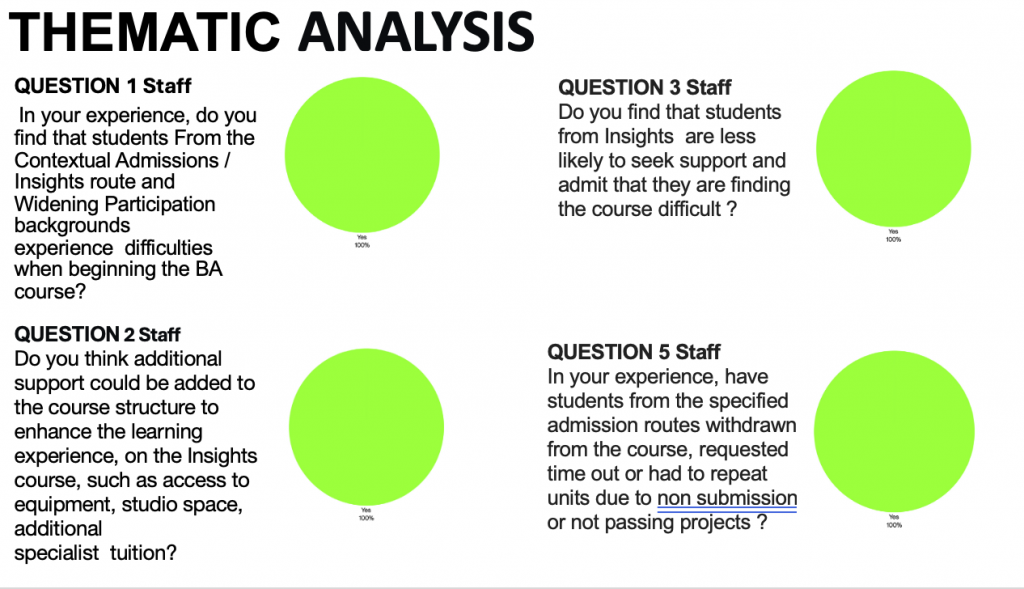
PLAN OF ACTION
•Conduct targeted research with close reference to the CSM Insights programme
•Be more concise in my approach by asking what barriers students experience with regard to the study I am conducting by collecting data from staff members and students within the department.
•Focus on steps that can be taken to make for a more supportive teaching environment and approach to social, racial justice.
•Interview fewer key individuals over an specific period of time.
•Interview staff members from different pathways to cross reference
•Work with collected opinions to create a study to propose action on embedding Racial and Social Justice.
•Manage time more efficiently: take on less data, allow more time spent on analysis. Reflect on any relevant previous studies made on my PG Cert.
REFLECTING ON MY INCLUSIVE PRACTICES UNIT
I have reflected on a previous blog post for my Inclusive Practices unit, that I wrote when looking into the evidence around attainment gaps for particular student groups within UAL.
Following the study of the attainment gap within UAL student communities there is an obvious disparity between white and Asian/black/mixed race students, where white students are traditionally awarded higher levels of attainment. The contributing factors of this can begin even before a student embarks on a UAL BA course through the complex disadvantages they are experiencing within their positionality.
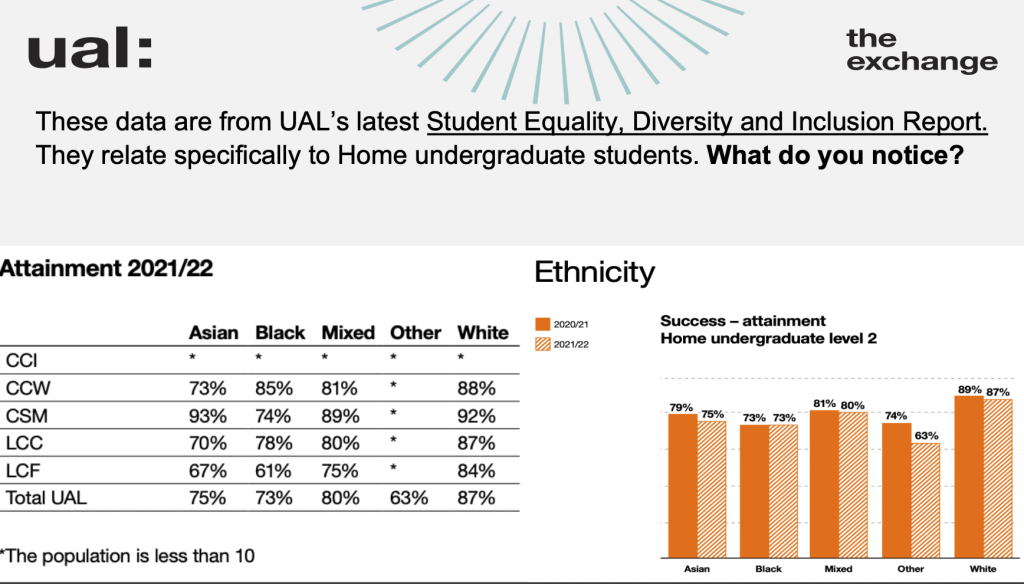
Students from more challenging backgrounds can often not want to declare a disability because they feel it might further disadvantage them. and students who have caring responsibilities for parents or siblings. Students from certain backgrounds often do not want to disclose the barriers they face even this impacts negatively on their work output and standards of achievement, because they are in an environment where they are alongside students from more privileged or affluent backgrounds who have the appearance of being high achievers and having a confident outlook and strong self belief due to the educational advantages and learning opportunities they have experienced in their upbringing such as short courses, private tuition and access to high quality art and design teaching in their educational environments.
[PDF] Students’ Experience of Identity and Attainment at UAL
D Subri – London:: Centre for Public Policy Research, King’s …, 2017 – academia.edu
WHY CITATION MATTERS
focussed reading.
Ideas on a Feminist Approach to Research
Christina Templin (SoSe 2021)
What we often don’t fully realise is that the knowledge we consume, produce and reproduce in this process isn’t always neutral. Elite groups who shape academic opinion and reinforce opinions of students and other academics, can often cite each other which perpetuates certain chains of paradigms of their traditional interpretations and opinion of the world.
Research into an area of study and reviewing existing academic papers, where each body of work builds on each other, it is necessary to thoroughly reflect on the work that has already been done on a specific question, to be able to draw new conclusions from analysing, enquiring, criticising or highlighting the more contemporary aspects of perceived educational structures from a piece of hierarchical analytical writing that already exists.
Current zeitgeists need to be considered from specific areas of social justice. Many existing forms of academic writing and analysis can reflect more dated viewpoints and don’t include current influences and shifts in the awareness of inclusivity of race and gender and also pushes for more diverse and wide ranging opinions from many stratas of society.
Even writing as recent as 2021 does not consider the positive activism and shifts in responsibility towards inclusivity and representation which arose from the Black Lives Matter movement and giving importance to influential groups who communicate strong opinion through their activism such as WE ARE FACE
Research and collecting data should be moving towards a more inclusive citation practice that can take into account various forms of knowledge that have previously been overlooked or are not widely available due to being excluded from mainstream academic arenas.
Sarah Ahmed Living a Feminist Life 2017 adopts a strict citation policy: “I do not cite any white men” “By white men I am referring to an institution, as I explain in chapter 6. Instead, I cite those who have contributed to the intellectual genealogy of feminism and antiracism, including work that has been too quickly (in my view) cast aside or left behind, work that lays out other paths, paths we can call desire lines, created by not following the official paths laid out by disciplines”
The following quote really resonated in terms of researching and then creating meaningful content.
“That is how it felt writing this work as well as speaking from it: being in the wind; being blown about, more or less, depending on what I encountered. The words I sent out danced around me; I began to pick up on things I had not noticed before. I began to wonder how much I had in the past built an edifice to create a distance. Sometimes we need distance to follow a thought. Sometimes we need to give up distance to follow that thought”
Moving towards a more inclusive system of citation and after reading this piece of writing, I was mindful about how my research could be influenced, enriched and directed by diverse opinion and data analysis and I considered the research I would be making myself and also by studying existing written papers and opinions and I thought about what I would be including in my citations for the Action Research Project, that I believe are approaches from diverse and relevant opinions.
Citational systems are a powerful tool that work to reproduce a discipline (Ahmed 2013) while upholding oppressive systems of class, racism and sexism in academia.
It is therefore necessary that we reflect on our own practices of how we use citations and knowledge production to avoid the continuation and therefore reproducing of these systems of oppression, which we wish to challenge and make more diverse and inclusive from different and often unheard voices.
20th November 2024
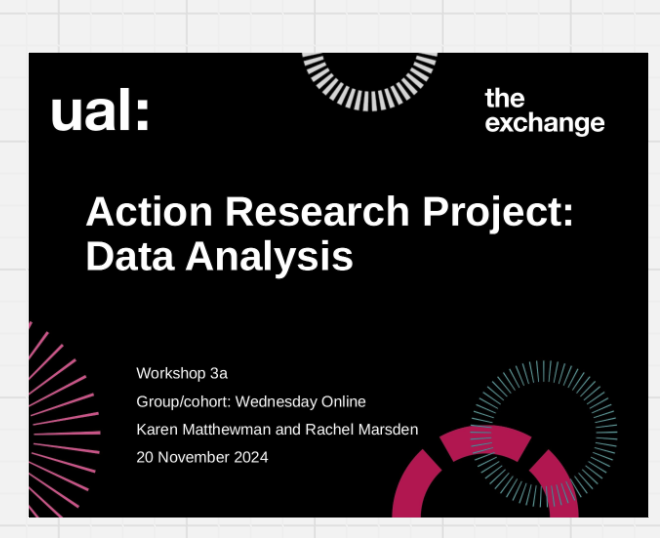
CREATING POETRY FROM DATA TO AID ANALYSIS
Illingworth, S (2022)
Edinburgh Napier University
Poetry can be used as a tool to re-anylise and present qualitative data through a new lens.
A really informative interactive workshop today putting this analysis tool into practice using an existing transcript from interviews about the purpose of going to university, and creating a poem to hi light key points and find a focus on a specific meaning.
Step 1: Identify 15 to 20 illustrative lines.
Having first familiarised yourself with your data (i.e. by reading it through several times), identify 15 to 20 lines that are representative of the overall narrative(s) or theme(s).
After you have identified these lines, write them sequentially, one on top of another. This is the initial poem with which you will be working.
Step 2: Assess the rhythm of the piece.
Definitions of what does and does not constitute a poem are long and storied. However, I think that overly restrictive definitions can be exclusionary, and as such I offer the following inclusive, and some might say very loose, definition: all poems have rhythm.
With this definition in mind, read through your initial poem, both out loud and in your head. Where does rhythm occur? Where is it absent?
Are there any lines that might benefit from repetition?
Step 3: Add and remove lines.
Edit your poem to address these rhythmical observations. For me personally, I believe that this precludes the addition of any words that do not appear in the data you are analysing. It is also important for any identifiable information to be removed at this stage. Such identifying information may either be explicit (such as name and job title), or implicit (such as personal history or favoured phrase).
Read through your data again; are there any other lines you can add to your poem? These lines must add to the rhythm but must also preserve the overall interpretation of the piece.
Step 4: Share.
Now that you have a non-identifiable piece of rhythm, it is time to share it. Acknowledging that the “final” poem that you produce, prior to sharing it with others, is not necessarily the final evolution of the poem affords both you and others an opportunity to revisit the poem and its potential impact.
In the workshop session, I chose sentences from the transcript that stood out to me that I felt reflected the huge expectations and pressures on students and how sometimes I forget how young and inexperienced they are.
Their own expectations are also high and they look to a university course to give them a life changing experience, which it should be – but they may not be ready for the challenges and workload along with their personal barriers and obstacles.
MY EXAMPLE OF CREATING POETRY FROM ANALYSIS
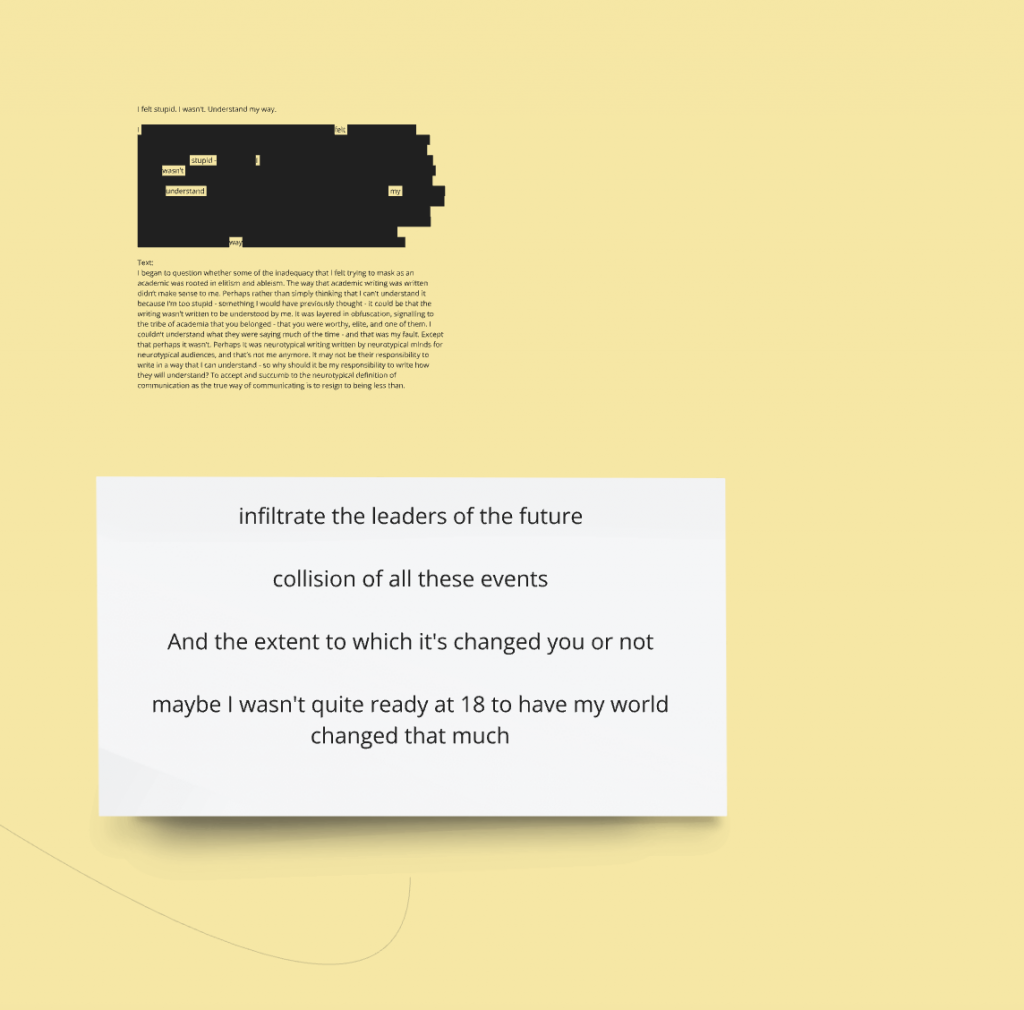
I DECIDED TO USE MY OWN TRANSCRIPTS FROM THE STUDENT INTERVIEWS I CONDUCTED, TO CREATE A MORE POETIC FOCUS ON KEY POINTS AND PHRASES.
Balancing this independence with the need for reassurance was difficult at times.
I struggled with not yet feeling confident
I am still working on understanding the full process
I found myself in positions of self-doubt, questioning my abilities and decisions.
this can feel isolating as you try to fit in,
I felt unsure.
I’m learning to lean on my strengths and trust in the growth that comes with taking on something new.
Building a strong relationship from an early age.
27th November 2024
Data Analysis
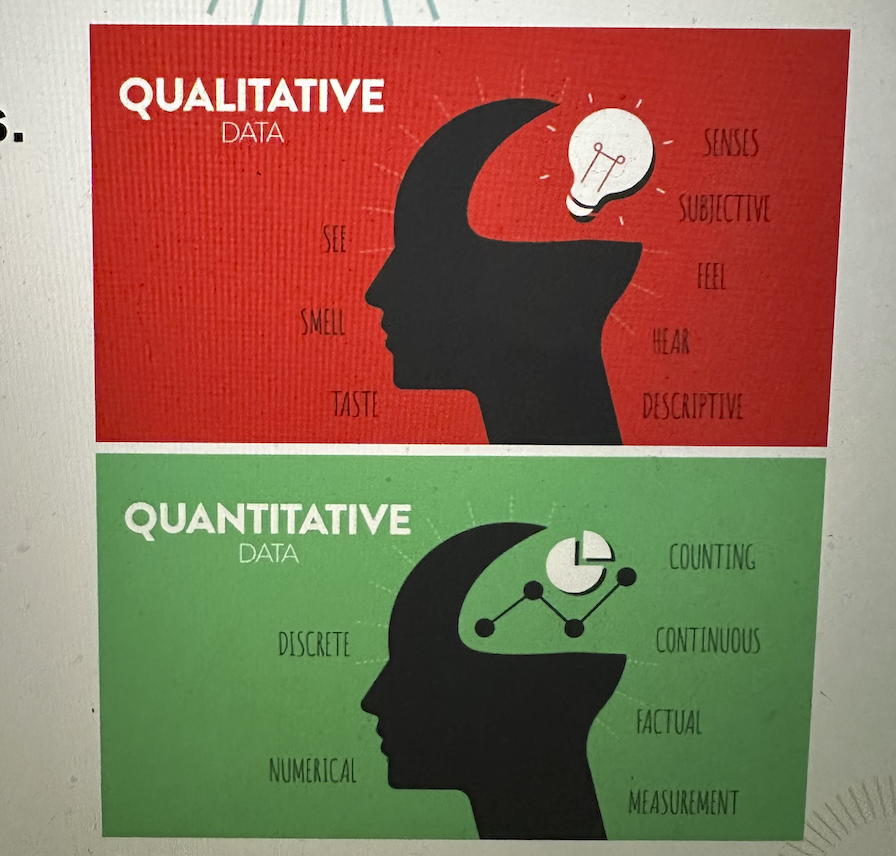
Working today in the workshop on the myriad of formats that constitutes data and how to extract key points and information to form cohesive, factual and analytical conclusions that should support the answers to the Action Research project focus.
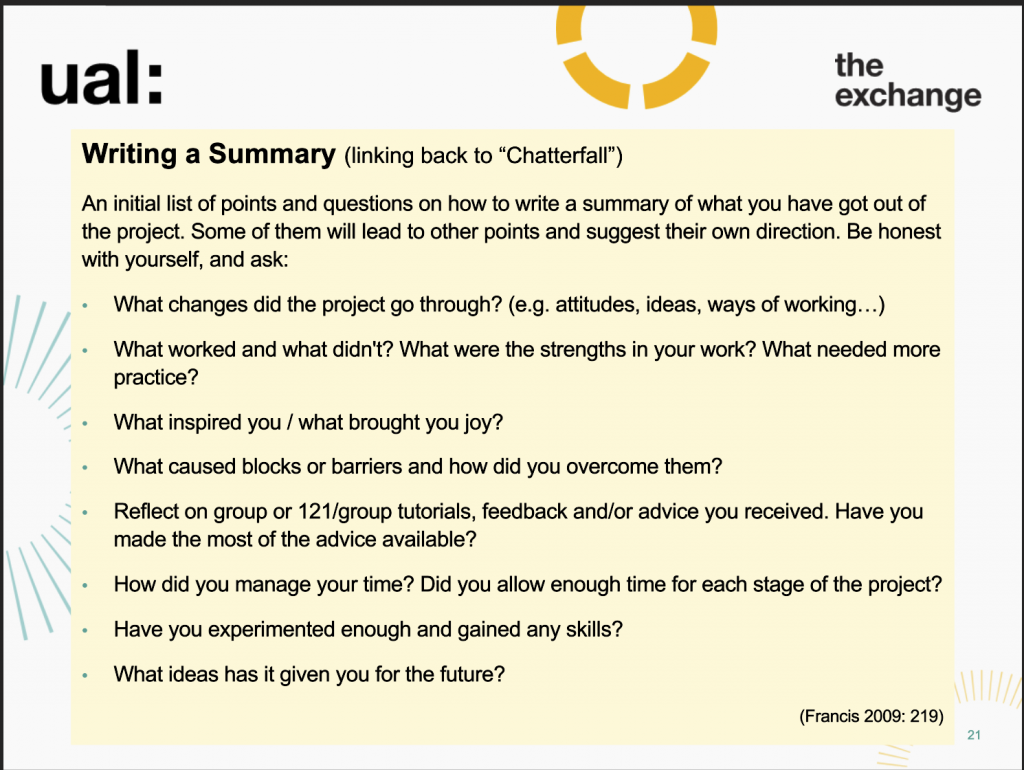
WRITING A SUMMARY
An exercise in pinpointing how the data has been collected, how this may have changed through the lived experience of the project and how it should be used.
What changes the project went through.
What was learned or proven
What effect this had on the project process and outcomes and what effect did this have on a personal level.
What changes did the project go through ? What worked and what didn’t ?
My Action Research project began at the outset as a much more unmanageable amount of work with too many unrealistic aims that required an initial study proposal. Through the workshops, tutorials and valuable feedback from my peer group, I adapted the project focus to be more of a study for a proposal which gave me a larger scope to work much more in depth on a more specific focussed area. I decided on the participants being limited to a select amount of staff and students, so that I could collect more data from fewer participants about their personal experience and valuable opinions.
What inspired you /what brought you joy
I have been genuinely inspired and moved by learning of the student lived experience and the barriers they have faced and overcome. This study has created an opportunity that I feel will be a relevant and necessary proposal to create a support system for students from widening participation backgrounds who I have found through my study of participant responses and my own experience, are really in need of additional support in creative and technical processes before taking on BA studies.
I have learned through collecting the staff data from the participants viewpoint that we have a sincere collective concern about improving the student experience and a feeling of responsibility to support students so that they can reach higher levels of attainment. The concerns of members of Fashion staff and the desire to support this study has inspired me to continue with this research.
What caused blocks or barriers and how did you overcome them
The main barriers were in trying to take on too much and initially not see the need to create a study for a proposal first. Once I had presented the more initial ideas and received feedback, everything was much clearer and I felt more in control of the whole process. I was able to create a targeted list of important questions and manage the participant input much more efficiently with a select number of staff and students and this enabled me to receive valuable information that I was able to use in this study.
Reflect on 1-2-1 / group tutorials / have you made the most of the advice available
The group online sessions, workshops and focus break out groups have created a strong bond between students and PG Cert tutors and a wealth of creative knowledge has been exchanged and I have really benefitted from peer assessment, advice and comments, particularly in the Action Research project. Comments and advice from my peer group who could review the proposal subjectively helped to steer my project into something more manageable and relevant. The online group has created strength, guidance and support throughout and a great sense of connection to like minded beings.
I have definitely benefitted and learned from the tutor and student advice, feedback and input which has helped me to understand my project more clearly.
How did you manage your time? Did you allow enough time for each stage of the project ?
I sent out questionnaires quite early on in the process, understanding that some of the data may take a while to complete, especially the from the students who are occupied with college work. I also decided to interview some participants who had too little time to write the answers, so it was easier to meet and record the answers myself. Being prepared early allowed me enough to time to manage the data and explore how to put this into context.
Most of the tutors I asked to take part sent their answers quite promptly because they really believe in this study and are keen to be involved in instigating a system of support that means they can be part of making students feel more integrated on their courses. We all collectively feel genuine concern that we are asked to recruit more students from widening participation backgrounds to fulfil the social justice agenda of the university, but we are aware that there is little in place to support students once they begin their courses.
Have you experimented enough and gained any skills ?
I’ve experimented widely with considering the magnitude and relevance of the project focus, and how to create a proposal for the social justice and ethical aspects, and I experimented with re-working the focus of the project, and the formatting and lay outs of the written questions to create a strong narrative and also I experimented with the edit and how the data is communicated on the pages.
My approaches in data collection, understanding ethics and anaIysing information have given me an opportunity to gain so much more experience and improvement of my skills from evaluating clear written statements to the consideration of how even small amounts of information can be highly valuable and relevant.
What ideas has it given you for the future ?
The study I produced and the information gathered from students and staff has created a strong argument for this proposal to continue to be researched further and the possibility of this leading to being put into practice in the form of a relevant support system that will make a marked difference to the attainment and retention levels of students from this entry route.
We are directed to offer a percentage of places on the BA Fashion courses to students from Insights and Widening Participation backgrounds, to fulfil diversity and inclusivity commitments, but students from this specific entry route are usually unprepared and lack the cultural capital, creative and technical skills to cope with the expectations and workload.
Lack of confidence and entitlement. But most importantly lack of sense of belonging and therefore, they find it difficult to find their community and group of friends and support
– Lack of understanding what research means
– Lack of understanding how to develop a narrative for a project
– Lack of understanding how to develop a project in general
– Little ability to draw
– Little ability to cut and make clothing
– Vitally all the above issues contribute to the fact that those students cannot actually enjoy the course which is really meant to be their best time of their life.
My conclusion supports my belief that we need to ensure that students are supported preferably before BA entry.
ANALYSIS // STUDENTS
After reviewing the student feedback, it was clear that the student participants agreed that they all experienced significant barriers to positively progressing in their learning.
The barriers identified from student experience are a combination of financial difficulties, lack of cultural capital creating issues around a lack of ability in conducting research through inexperience in using a library and having little opportunities to frequently visit exhibitions and museums, insufficient skills in concept building and lacking confidence in drawing and technical skills to allow freedom in creative experimentation. This also led to issues around not feeling a sense of belonging and they find it difficult to find their community and group of friends and support.
We are directed to offer a percentage of places on the BA Fashion courses to students from Insights and Widening Participation backgrounds, to fulfil important diversity and inclusivity commitments, but students from this specific entry route are usually unprepared and lack the cultural capital, creative and technical skills to cope with the expectations and workload. We need to offer support for these students to ensure we don’t create a situation where we set them up to fail.
I have been deeply moved by learning of the student lived experience and the barriers they have faced and overcome. This study has created an opportunity that I feel will be a relevant and necessary proposal to create a support system for students from widening participation backgrounds who I have found through my study of participant responses and my own experience of teaching, are really in need of additional support in creative and technical processes before taking on BA studies, so that they can feel a sense of belonging and are enabled to create ambitious work.
ANALYSIS // STAFF
After reviewing the staff feedback, it was clear that all staff participants agreed that students from the Insights programme are experiencing significant barriers to positively progressing in their learning..
The barriers identified from staff experience are a combination of financial difficulties, not having access to equipment and not feeling a sense of belonging due to a lack of cultural capital, ability in conducting research through inexperience in using a library and having little opportunities to frequently visit exhibitions and museums, insufficient skills in concept building and lacking confidence in drawing and technical skills to allow freedom in creative experimentation.
There is a perceived connection between the specified barriers and attainment and retention levels, and a link between students not achieving good grades, high rates of non submission of projects and a significant number of students re-submitting failed projects, taking time out of studies and in some cases leaving their courses.
I have learned through collecting the staff data from the participants viewpoint that we have a sincere collective concern about improving the student experience and a feeling of responsibility to support students so that they can reach higher levels of attainment. The concerns of members of Fashion staff and the desire to support this study has inspired me to continue with this research to create a workable solution.
There is unanimous agreement that additional support pre-BA entry through additional contact with BA Fashion tutors delivering sessions in research concept building, drawing and some initial technical skills could help Insights students feel more prepared for BA studies and contribute positively towards integration into the course structure.
UNDERSTANDING THE EXPERIENCES OF STUDENTS TRANSITIONING ONTO BA FASHION COURSES
By analysing information provided by student participants in the survey, I determined key areas across the student experiences that created significant barriers to their learning.
Feeling unprepared for BA level studies and needing more support and tuition in research, drawing and creative development skills and in basic technical approaches.
Not feeling able to relate to peers or feel that they fit in and they are able to produce work of the same standard as other students who had previously studied fashion or had intensive training prior to starting the BA course.
UNDERSTANDING FROM THE STAFF POINT OF VIEW
By analysing information provided by staff participants in the survey, I determined key areas that created a unanimous consensus that students from the Insights programme traditionally experience barriers to their learning and identify that this contributes towards lower attainment levels and retention.
Financial constraints that create restrictions and owning necessary equipment.
Lack of cultural capital due to traditionally not visiting galleries and museums and travelling outside of communities.
Lack of understanding what research means, how to develop a narrative for a project and how to develop a project in general
Little ability to draw or understand how to cut and make clothing.
PROJECT FINDINGS
Undertaking this Action Research project has highlighted specific barriers students from widening participation the CSM Insights programme face when embarking on the BA Fashion courses and it has allowed me the privilege of hearing about how their experiences and how they have navigated many obstacles.
The student feedback from the questionnaires has allowed me to understand their needs specifically related to where they feel they needed more support before embarking on a BA Fashion course. I now have a more clear understanding of how I could focus my action research question if I were to continue further with this research.
IDENTIFYING SPECIFIC SUPPORT NEEDS
From collecting and analysing the data responses from the targeted questionnaires that were sent to student participants, I found there was a definite need to propose a system of support to help students and staff from the Insights programme to prepare students for the transition on to BA studies.
This system of support should be ideally offered during the Insights tutorial programme during the Autumn term and also in the Summer school programmes.
I have identified the key areas of support that are needed to support student learning.
1 Additional support in creative research skills including using the library
2 Concept building using visual research
3 Drawing techniques
4 Technical skills such as using a sewing machine and initial cut and drape techniques.
PLAN OF ACTION
PLAN OF ACTION
1.To present my Action Research project findings in depth to BA Fashion staff.
2.To work collaboratively with the Insights practitioner team and BA tutor team to implement additional support.
I WILL PROPOSE THE FOLLOWING PLAN FOLLOWING MY STUDY
1.A library research session to support students in how to use the library services with the dedicated fashion librarian at CSM.
2. Sessions with BA Fashion staff on concept building and how to process visual research.
3. Fashion drawing classes with an illustration tutor.
4. Workshops with a technical tutor in basic skills in cutting, drape and inductions in how to thread and use a sewing machine.
To work collaboratively with the Insights team on how they would like the BA Fashion tutor team to implement additional support and decide If this will be scheduled for the Insights Summer School or if they also need a plan in place during the term time tutorial sessions.
Decide on the amount of support sessions and the number of tutors involved.
All Pathway Leaders in Fashion are keen to be part of the support group.
To work on a plan with the fashion staff team on how to deliver targeted support.
PROPOSAL // SUPPORT STRUCTURE
1.A library research session to support students in how to use the library services with the dedicated fashion librarian at CSM.
2. Sessions with BA Fashion tutors on concept building and how to process visual research
3. Fashion drawing classes with an illustration tutor.
4. Workshop in basic skills in pattern cutting, drape and inductions in how to thread and use a sewing machine.
my reading list
Students’ Experience of Identity and Attainment at UAL
D Subri – London:: Centre for Public Policy Research, King’s …, 2017 – academia.edu
The Theory and practice of culturally relevant education, Aronson B. Laughter
A Pedagogy of Social Justice for Education:Society,Identity,Theory, Intersectionality and Empowerment Hahn Tapper, AJ
END OF ACTION RESEARCH PROJECT BLOG
T.P.P UNIT
-
ARCHIVING
This week, I have been reading about archiving and how an archive can represent and contextualises society. After studying the written material entitled
Archiving Critically:exploring the communication of cultural biases, by Hannah Grout, I focussed on key points around the existence of archival bias and how to present pedagogy as a solution to the apparent lack of documenting and recording materials and objects that are more inclusive and representative of the wider truths of global societies and curating items relating to more diverse groups.
An archive is seen to hold the truth and signify what a society has deemed worthy of preserving for future generations to experience and learn from. An archive can hold items which record human experiences, achievements, skills, events, memory and traditions and communicate wider development of cultural awareness.
There are many absences within archives where there is much unrepresented and un-documented material which often relates to gender, disability, race and socio economic groups. As society evolves and shifts, concepts of truth and history need to be redefined through what is documented and preserved and seen as important, so that all creative aspects of society, culture and sub cultures are curated and recorded.
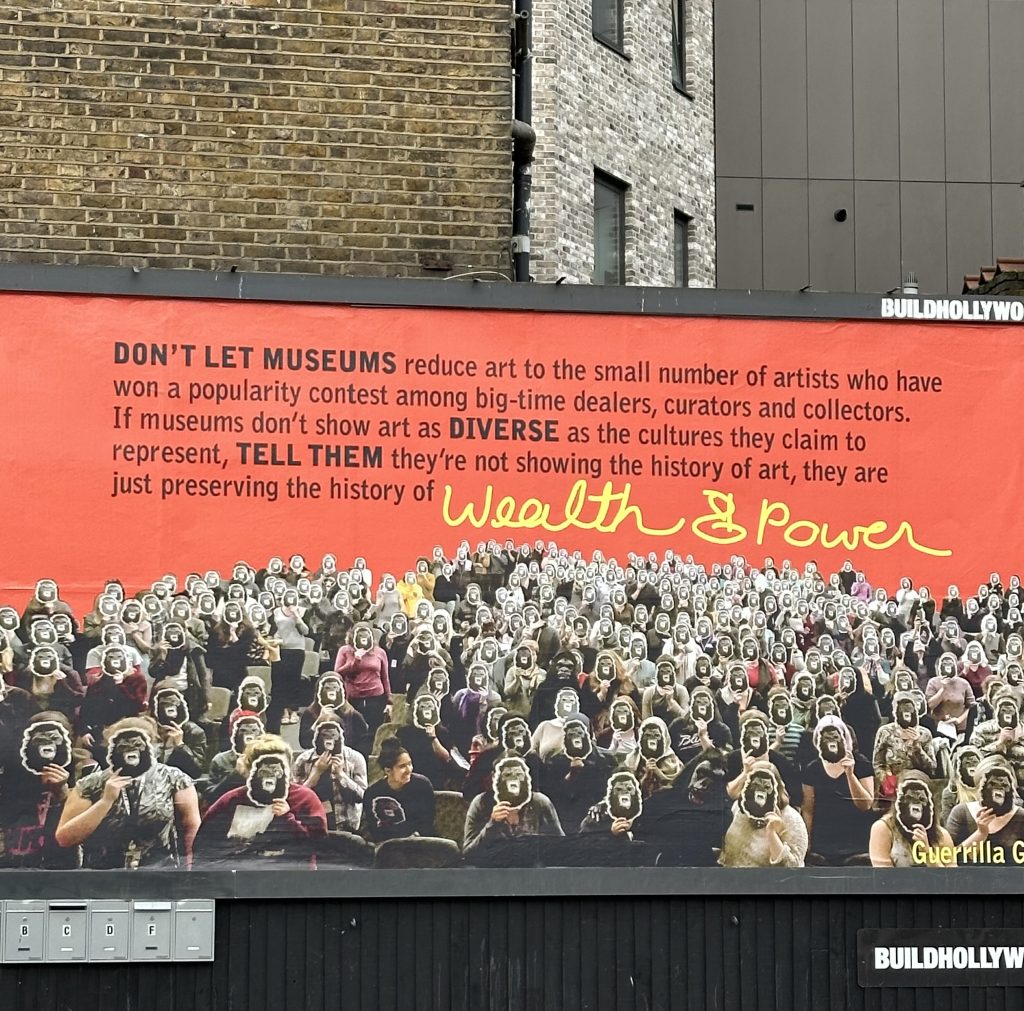
I am currently working on producing a digital archive for Fashion after receiving an award from the CSM fashion fund through my knowledge exchange practice. The garments recorded for educational study will cover ethnographic, socio economic, contemporary and iconographical pieces to cover diverse aspects of clothing and the meanings held within them.
I’m particularly interested in clothing being carriers of human existence and the the memories that materiality within clothing holds. Material culture and textile creation is inherent in all society and clothing is present in most human experiences. Reading the information in the written piece will inform my own choices about with items of clothing to document.
https://sparkjournal.arts.ac.uk/index.php/spark/article/view/120
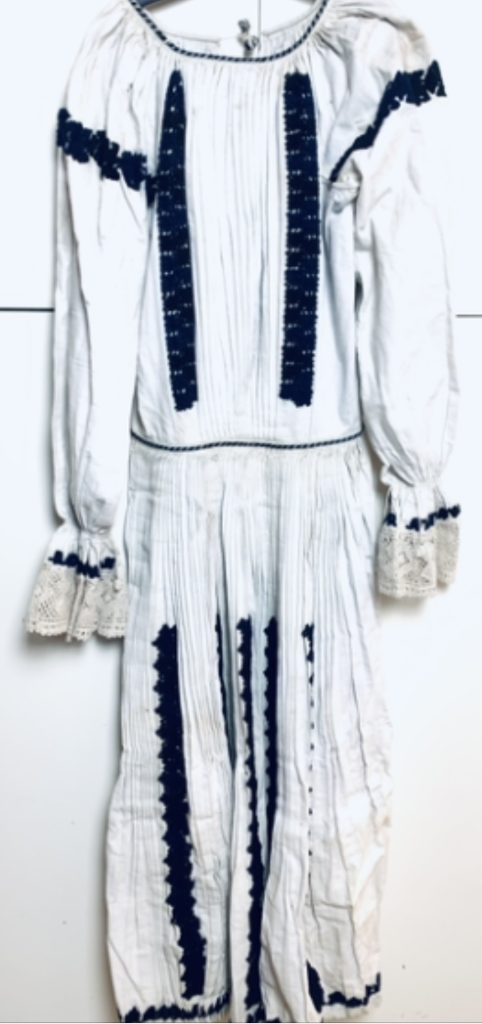
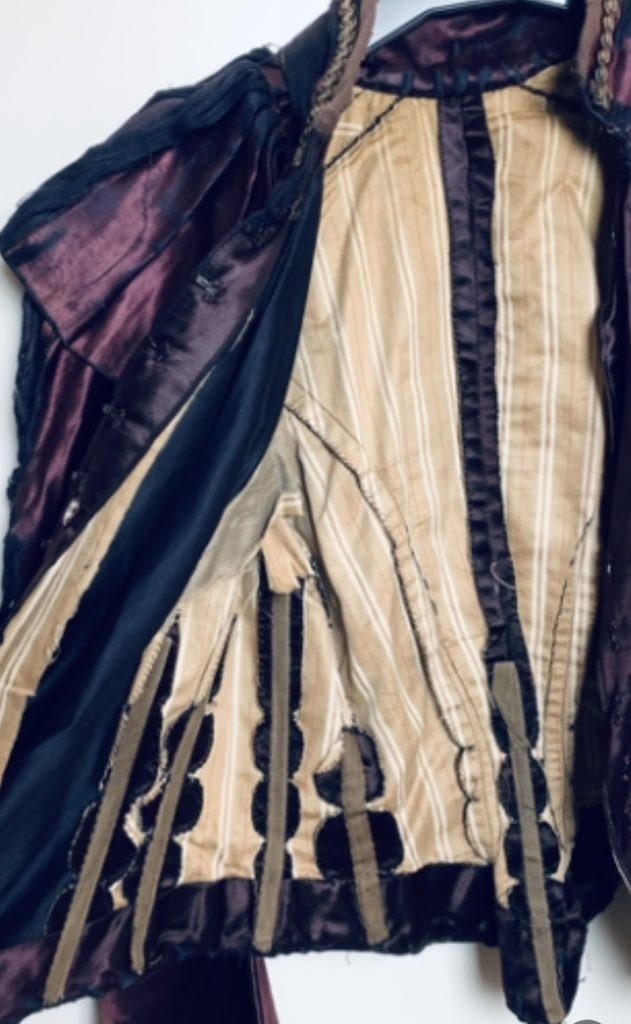
MICRO TEACHING
7th February 2024
20 minutes teaching session.
I chose to focus on object based learning and present a garment from my personal Fashion archive and introduced a discussion on how to unlock codes and narratives within the perceived or imagined history of a chosen piece. Clothing can hold information within the shape, construction, materiality, colour and making processes, so there are many stories and meanings to discover. The areas of analysis can be focussed on in 3 main areas
ETHNOGRAPHY — SOCIO ECONOMIC — ICONOGRAPHICAL
My teaching plan allowed the group to examine the object without needing any specific knowledge of Fashion history and to think about each of the areas of focus to assist the analysis and consider the possible narratives within the clothing piece.
5 minutes to discuss the garment piece and study the detailed images.
10 minutes to discuss the clothing piece and analyse how it can be discovered in each of 3 the areas of focus Ethnography, Socio Economic, Iconographical
5 minutes to discuss conclusions and focus on what are the modern parallels within analysing codes within contemporary pieces of clothing and how we communicate our identity and personal stories within in our dress codes.
Clothing can communicate ETHNOGRAPHY/ where in the world it was made and worn, SOCIO ECONOMIC /the identity and social standing of the wearer, and ICONOGRAPHICAL/ the classification or purpose of the clothing piece.
Why did it exist ?
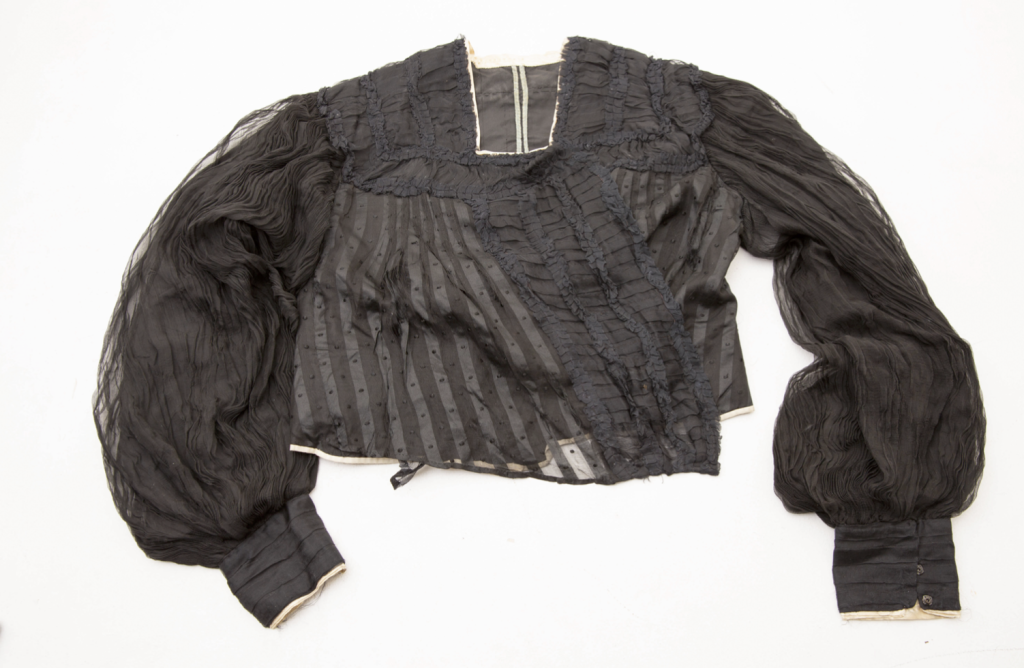
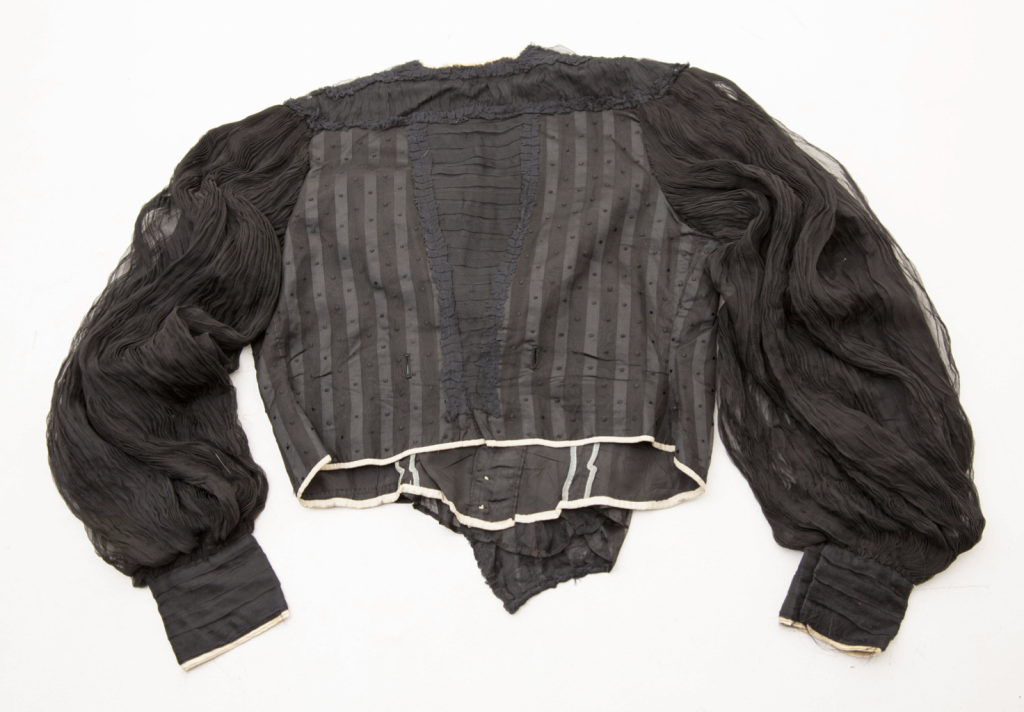
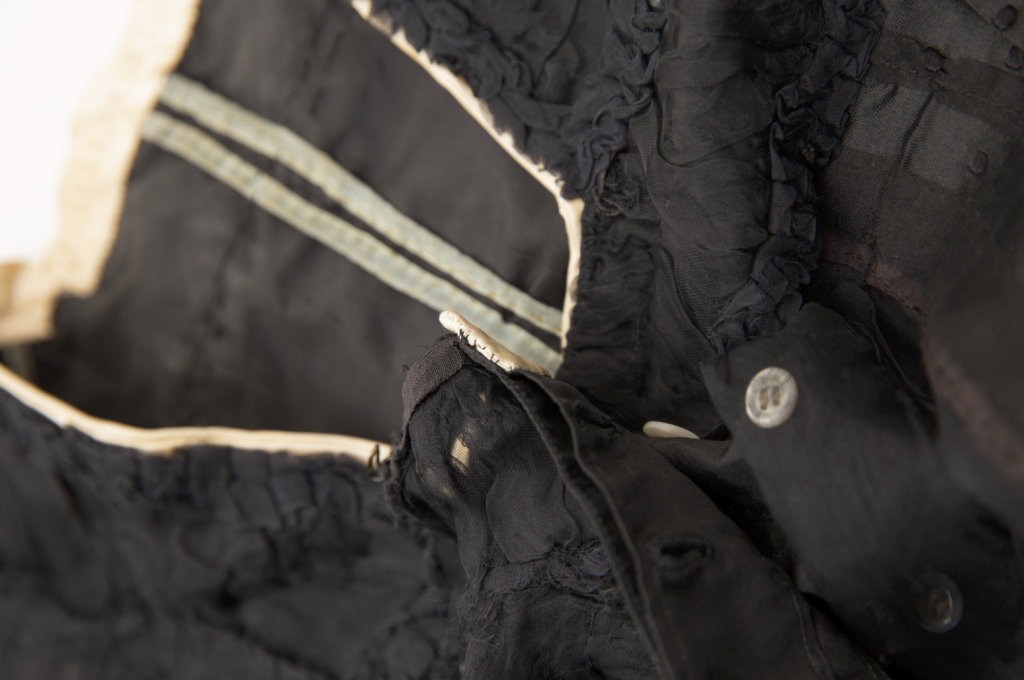
Our clothes touch our skin, meet people and go to places, they absorb memory and experiences within their fabrications, they communicate our identity, opinions, tastes and obsessions and we imprint ourselves on our clothes through the wearing of them. This was not so much about a detailed fashion history lesson, it was intended to open up a debate about how to discover stories within clothing and asked for opinions and suggestions based on purely looking at the constructions, materials and details.
This garment was discussed as a group and Ethnography could be identified as being of Western/European origin, 19th Century and a high fashion garment from a person in late stages of mourning who was of high wealth and social standing. The style, shape and construction of the clothing piece is clearly related to later 19th century European Fashion.
In terms of Socio Economic, the fabrics are a key element in the analysis, the garment being made in silk chiffon, silk taffeta and silk brocade, which in that period of time were very expensive, refined and opulent materials, possibly imported from China, would mean that the owner would be a person of wealth who would be aware of applying identifiable social etiquette and correct coding to their dress.
In terms of classifying the Iconographical aspects of the piece, and the purpose of the clothing’s existence in the life of the wearer, as a female in mourning, much of the weight of the protocol and etiquette was applied to women’s dress, around displaying the correct stages of mourning and awareness of being visible in public appearances and the necessity in communicating correct formalities and social standing. through her clothing. The later stages of mourning would allow a more decorative garment and the introduction of trims, beading, or some lighter colour.
In this garment there are many fashionable chiffon frills around the front and neckline and at the hem, and a cream decorative binding at the neck and hem, with closures of cream mother of pearl buttons, which are clues that this would have been worn after the 1st period of mourning, which is identified by the wearing of sombre plain black materials with no decoration.
By analysing the 3 areas of study, Ethnography, Socio-Economic, Iconographical, the team could unlock the stories without a deep knowledge of fashion history. It was great to introduce this way of exploring codes within clothing pieces and the closing discussion related more to contemporary fashion and how these areas are communicated through modern clothing where logos, branding and visible signs of wealth are applied to clothing to communicate personal status, taste and opinion.
Thanks to Carys, Emily, Sonia and Nina for your comments and suggestions in discovering this clothing piece and the possible stories within it, and for allowing me to talk over you when you were about to break the dreaded silence!
There is so much fear attached to someone not speaking in an online session, an issue I often encounter which was discussed in the feedback. A few seconds of silence when someone is considering a reply to a question can seem like an age to the presenter, and there is always the feeling that a lack of speaking equates to a lack of engagement and that silence needs to be filled immediately by talking to fill the void when one of the participants might want to contribute. .
My learning from this and how I can consider my delivery when holding online group meetings, was that all participants were really invested in the session but needed a little time to consider the questions and how to answer, and this was not an indication of a lack of understanding or engagement in the content. This provided a really valuable learning experience in a wholly supportive and constructive environment.
AIMS OF EDUCATION
What are the aims of education?
As a group of Educators sharing a learning space, we considered what the aims of educating are, what it can mean and why do we do it, also how we categories and contextualise the meanings from our experiences in our own practice.
What do we aim for and intend to communicate when working with students and what are the Opportunities and Challenges that are attached to education.
Dividing our descriptors into 3 areas we considered how the process of Art and Design education is multi faceted and has many aspects and meanings.
Practical and creative processes through DOING and Developing the Future Doers and Makers
Technical skills/ Encouraging Risk Takers/ Communication and Collaboration/Entrepreneurship
Encouraging creative development through THINKING and Developing the future Thinkers
Knowledge Acquisition/Community Collaboration/Increasing Awareness
Personal expression of Identity through EMOTIONAL freedom and self attachment to Creative Output
Becoming/Self Actualisation/Innovation/Self Expression/ Enlightenment/ Cultural Understanding
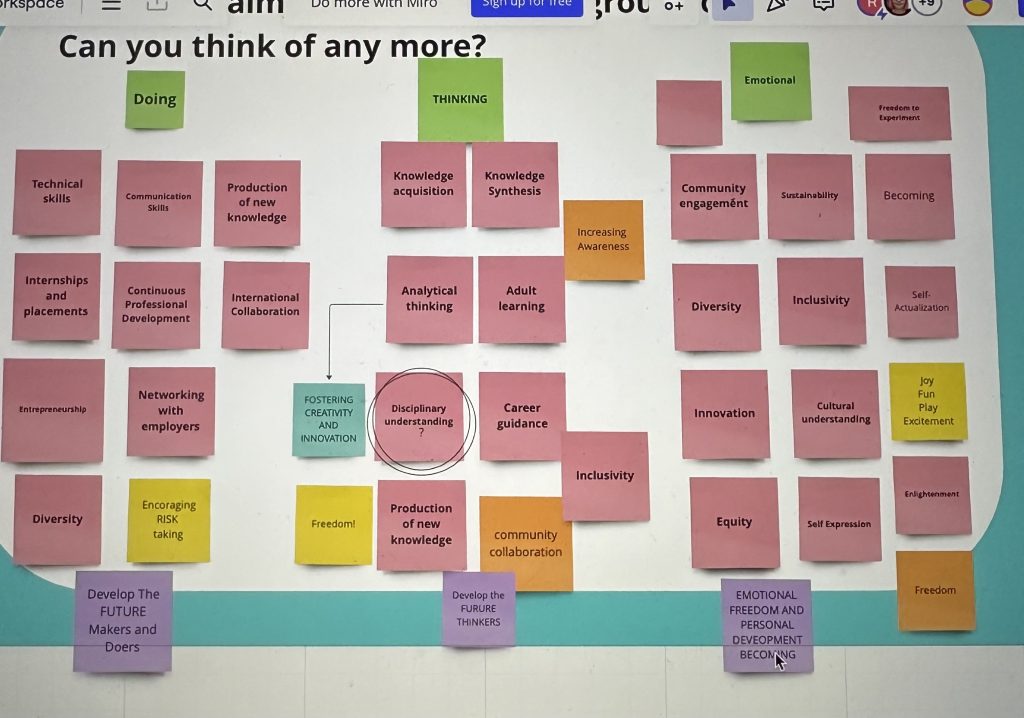
As a group we considered varied texts and aphorisms which describe the needs and benefits of education. There were specific written pieces, in particiular, Maximising Student Learning Gain (2015) by Graham Gibbs to reference and also 2 written studies to compare and contrast in terms of the priorities that 2 institutions had chosen to communicate why we educate and what it means to global communities.
Education according to UNESCO
Empowers/ Informs /Creates Better Futures/ Promotes Autonomy and Critical Thinking/Addresses the Interconnectedness of all Entities on Earth/Contributing to Better Futures for all by 2050/Focusing on Connectivity Improvement and Critical Reflection.
Education according to the QAA
The Capacity to be Creative/Intellectual Enquiry/ An Ability to Conduct Research in a Variety of Modes/The Capacity to Work Independently, Encouraging Resilience and Self Determination/Skills in Team Working/An Appreciation of Quality and Detail
The diverse similarities and meanings attached to Education are all relevant and varied but can be attached to different interpretations according to the context of how education is seen to be beneficial in different viewpoints and when applied to a specific set of criteria. This became apparent when reading and considering each of the documents.
Opportunities and Challenges attached to Education are many and varied. We worked in pairs to discuss our individual Opportunities and Challenges and found mutual similarities .
OPPORTUNITIES
Limitless Creativity/ Self Expression/Working with a Global Student Community/ Forward Thinking Creative Activism/
CHALLENGES
Creating Learning Communities without Studio Access/Working with Students with Diverse Needs/Planning in an Environment where things Constantly Change / Finding Sustainable Approaches that Address Planetary Issues/
Reflecting on a Reading Task
Aesthetic Learning About In, With and Through the Arts.
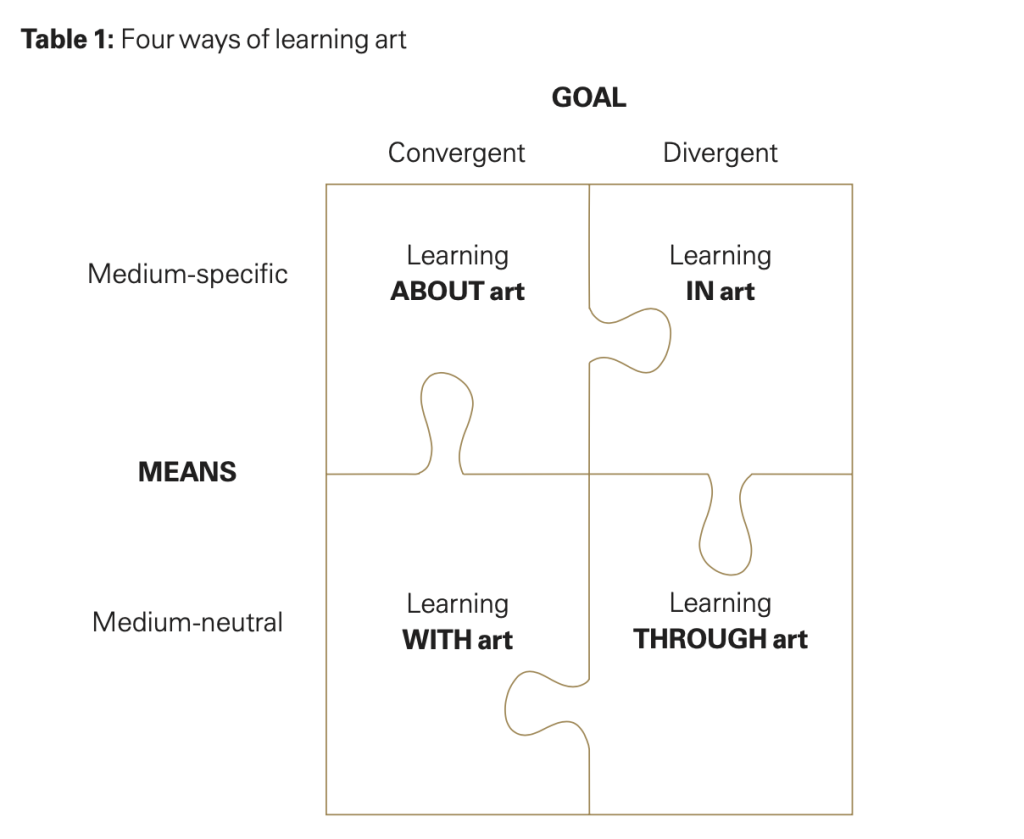
Learning WITH refers to the integration of art with subject matter from other disciplines which can refer to how students research around a concept and then produce a more personal creative expression from reaction to this which is essentially spontaneous responses and acting on creative impulses through drawing, making, documenting and reflecting.
Learning ABOUT refers to the basics of art education, from the elements and principles of design to knowledge about artists, styles and genres, which implies a more conscious based effort to learn through a more contextualised and guided experience.
Learning IN refers to the experience of a personal journey by exploring, exhausting creative possibilities, experimenting with materials, shape constructions and techniques in order to achieve an intentional physical and visual outcome which communicates a point of view, convey a message, a mood or poetic state of mind.
Learning THROUGH refers to the discovery of a personal development process through self discovery, experimentation and creative thinking, acting on and responding to creative impulses that students might achieve by involving themselves in an aspect of researching the creative arts, identified as persisting, expressing, making connections, observing, envisioning, innovating and reflecting.
OBJECT BASED LEARNING
CSM Museum and Study Collection
https://collections.arts.ac.uk/collections/csm
A video on the Museum website by Judy Willcocks on Emotional Readings encourages the viewer to think about the way our emotions effect the way we interact with objects. Instinctive reactions of like or dislike, emotional or extra-rational can form opinions that lie beyond rationality. Something that might appear to be purely instinctive when reacting to objects is more likely to be defined as a more considered response formed from opinions embedded in the human psyche from a complex mix of memory and personal experiences and also an unconscious bias that might have been instilled in us since childhood to form opinions around culture and identity. We are more comfortable with something familiar and what can be immediately understood, so how do we react when confronted with something not familiar or what can’t be easily visually identified or explained. How do we form an unbiased and instinctive point of view or opinion ? A series of questions is asked of the participant when exploring an object and opinions can be analysed using life experience, disciplinary training and cultural background to form responses.
What does this object remind you of
What else does this object make you think of
Does it evoke positive or negative memories
How does that influence the way you encounter the object
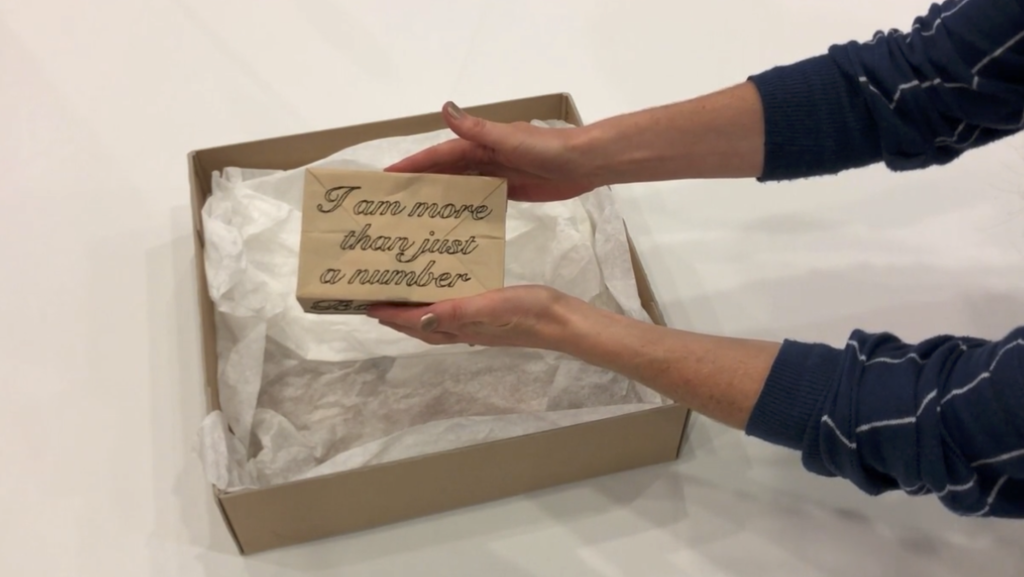
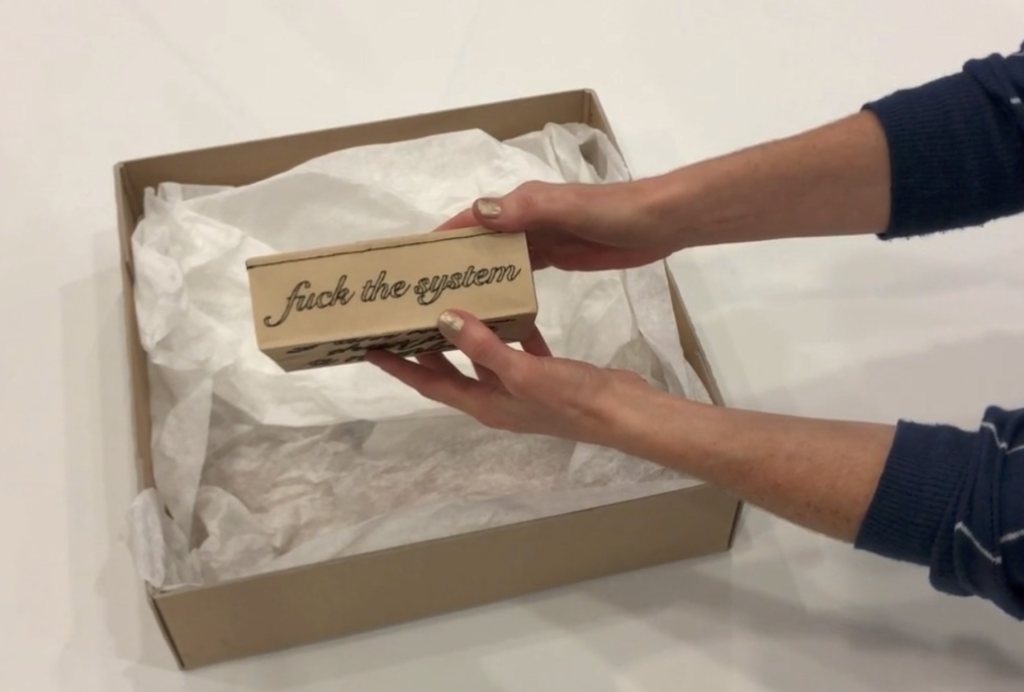
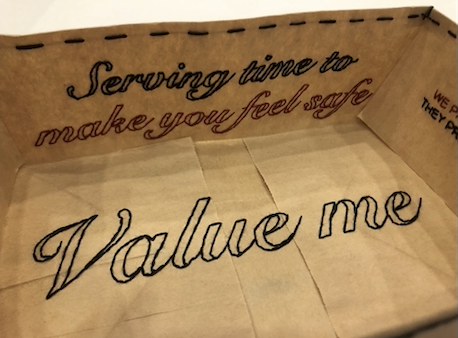
How do you react physically or psychologically when encountering the object?Consider the preconceptions you might have around gender, race, culture and identity and consider how this that might change the way you see and encounter things.
I visited Judy in the museum on 20th February to further investigate the Museum Collection with a view to designing a group workshop and consider how it could contribute positively to the student learning experience when applied to a specific project and set of learning outcomes. My experience is that students less and less are experiencing, encountering and using physical objects to explore their research, so this purely object based learning is really important to instil a physical research practice when studying Fashion, which is a highly tactile and 3 dimensional subject.
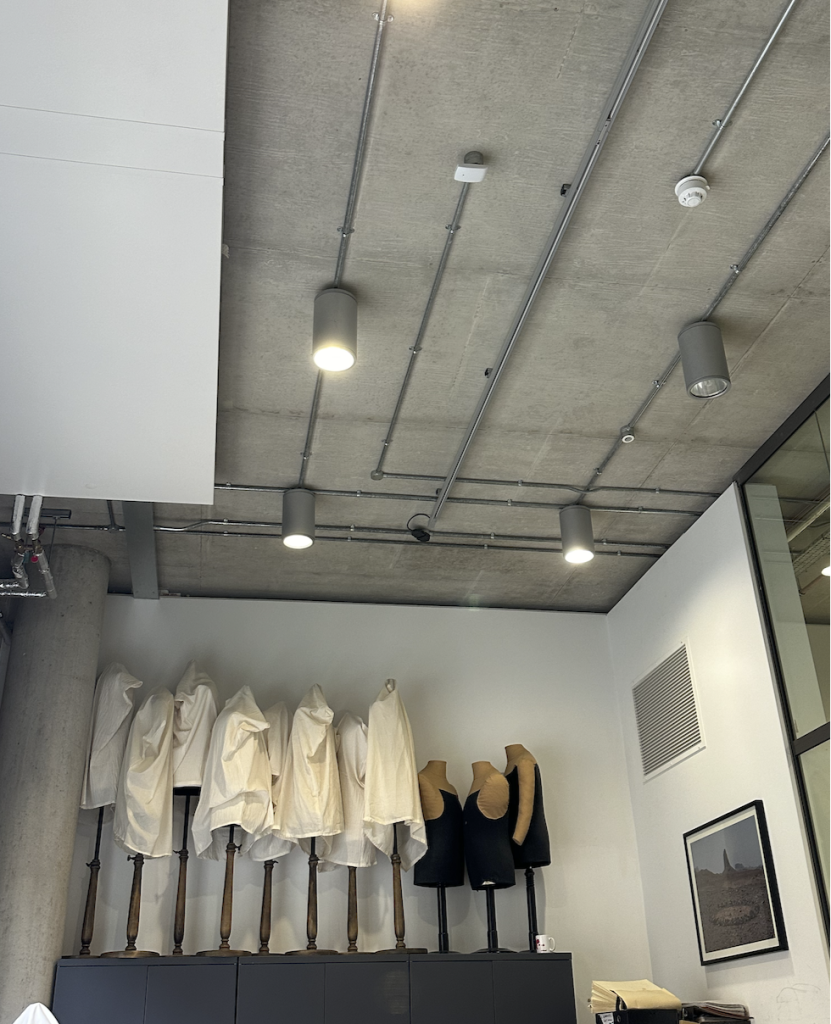
We planned an interactive workshop and object learning session for 2nd year Fashion Design:Communication students in the Summer term to view some archive clothing pieces related to their up-coming Creative Cutting project, which will be selected for their particular attributes of experimental construction, materiality and shape. This activity of learning through specific clothing pieces will be combined with an object based learning exercise where they will consider a chosen object and record their instinctive responses and feelings when encountering it.
I learned about the diverse collection of historical and contemporary clothing pieces, objects and art and design artefacts that are available as study pieces and also that the Museum purchases each year an item from the BA Fashion Collections. This is decided on by a panel and is particularly focussed on representing the diversity of the Fashion cohort and the varied and wide ranging cultural backgrounds and personal stories presented in the clothing designs are reflective of who we are as a creative and inclusive institution.
Judy uncovered an embroidered jacket by a past student, Angelica Ellis whose Collection drew on personal cultural references from her black British background and was richly embellished and symbolic of hand worked craft and personal heritage. The Museum chose this piece to represent the diversity of the BA Fashion cohort within the archive collection and to continue to represent the university through a collecting an inclusive selection of objects.
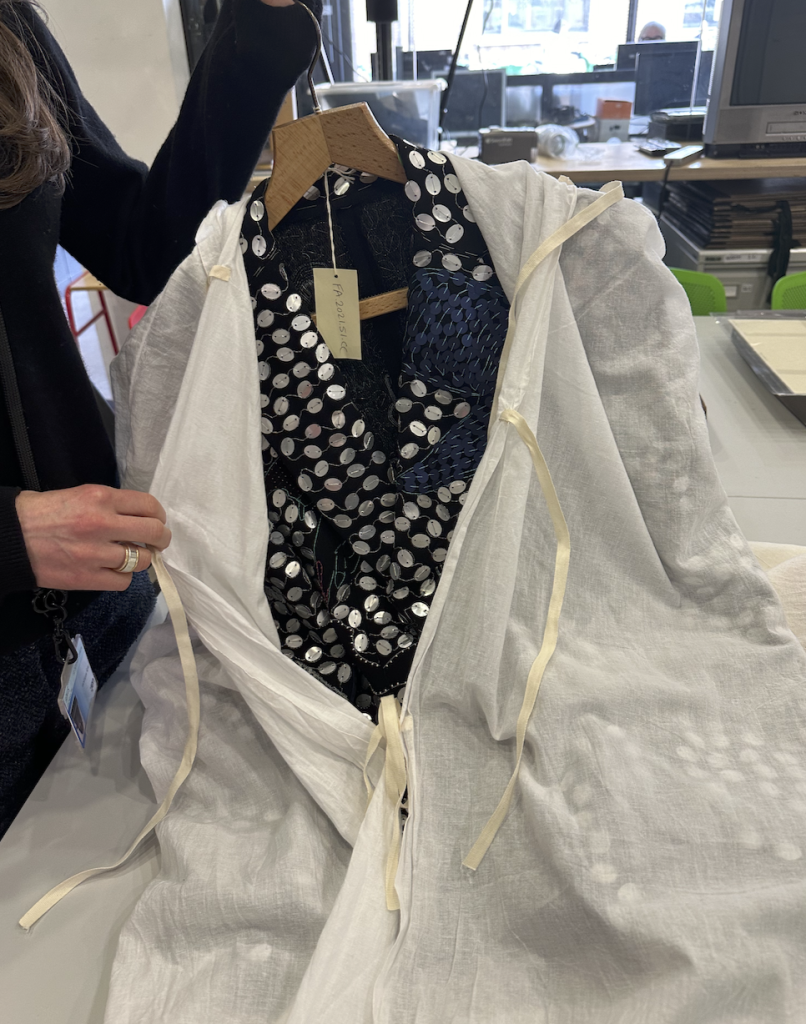
Thanks Judy !
ASSESSING LEARNING AND EXCHANGING FEEDBACK
CRITS AND INCLUSIVE LEARNING
Following a workshop on Assessment and Feedback, there was an open discussion on memorable experiences related to assessment, a personal insight or valuable lesson learned about the educational assessment of creative work, and a hope or expectation for the future assessment in the arts. The assessment process in the form of a Crit, is a model of communication and presentation of work, and a way of learning where students present their work to a group to gain constructive critique on the creative developments and project outcomes that have been executed in response to the brief. Students are also given feedback on how to develop their work further for the future. There are many barriers in presenting work publicly, which can be an intimidating experience for students. The requirement for students to assess themselves and their peers can create stress in a student and can be counter productive as a learning experience.
I usually invite one or more industry professionals to project crits so that students receive feedback and critique from a respected voice outside of the university tutor team. This can be intimidating for some students as well as providing an exhilarating experience where they are given advice and suggestions from practising Fashion designers. I considered the information in the writing by Dr Blair about crit formats and the issues attached to a more formal crit and thought about how this could be more structured to be in the form of a live exhibition or celebratory event or gallery launch, with students curating their own space in the Street area and other spaces at the Kings Cross site that could be visited by the tutor team, invited industry guests and the student peer group over the whole day allowed for the critique, and how this would compare to a student standing alone in front of the group presenting their work. I wanted this to provide an alternative way of presenting their process and project outcomes to the student group and tutor team, that would encourage more confidence and less stress in the participants.
http://arts.brighton.ac.uk/__data/assets/pdf_file/0015/66012/B-Blair-article-Pages-10-13-from-Networks01.pdf
Dr Bernadette Blair examines the design studio critique in Perception/Interpretation/Impact (2007) and states that the learning benefits should be :
To reflect on their own learning in relation to their peers
Learn from their peers
Clarify ideas
Practice presentation skills
Develop their critical awareness
Receive feedback from their tutors and their peers
Test ideas in a supportive environment without the pressures of the ‘real world’
This list of what a student should gain from a critique could still be achieved by arranging a different structure to the normal model of the crit format and allow the student to successfully present their work and be given feedback and be assessed. Thinking about the question on a hope for the future of assessment in the arts, it opened up an opportunity to consider a different format to the criteria model.
Dr Bernadette Blair writes that every student interviewed commented on how difficult they found the experience of standing up in front of a large group and presenting their project outcomes in the crit format. Students stated they were overcome with fear and did not hear or remember what they had said or what had been said to them about their work. The question is asked why does the crit scenario have such extreme emotive responses from students? There does not seem to be any other scenario in studio based education where this takes place. After reading this, I thought about how to structure a crit by not using the normal model of a student standing in front of a group and presenting their work, and instead to try to create a more interactive and less pressurised event to end the project where students curate their own exhibition space and invite the tutor team and other students to view their work throughout the day and receive feedback. The process and outcomes produced by the students are still able to be assessed and graded using this method of presentation as there would be ample time to view and give feedback on the work during the time allowed for the presentation event.
Reading Art Crits : 20 Questions. A Pocket Guide , Sarah Rowles
IBSN :0956435521;9780956435521, this unpacks, enlightens and illustrates the many forms that can be identified as a crit format. The purpose of the Art and Design crit is described as providing an opportunity for creatives to gain feedback on their work and learn more about their own interests and ways of working. Crits also provide all involved with an opportunity to learn from the work and perspectives of others, to develop skills in talking about work, to think about presentation and what the wider context is for their work, and prepare for life after education. It is important for students to have the opportunity for their work to be discussed so they are able to see how what they have created is being communicated to their peer group or a wider audience. This equips a student with powers of critical awareness. Students learn from each other. The crit exposes them to different types of work and approaches and new ways of thinking how to develop, ideas through peer observations. Students become familiar with talking about their work and develop skills in articulating through language the peer to peer sharing of information.
15th March Visual Identity Project presentations.
A live launch event designed by the student group to showcase project outcome work with feedback and critique.
2nd Year Fashion Design:Communication BA students
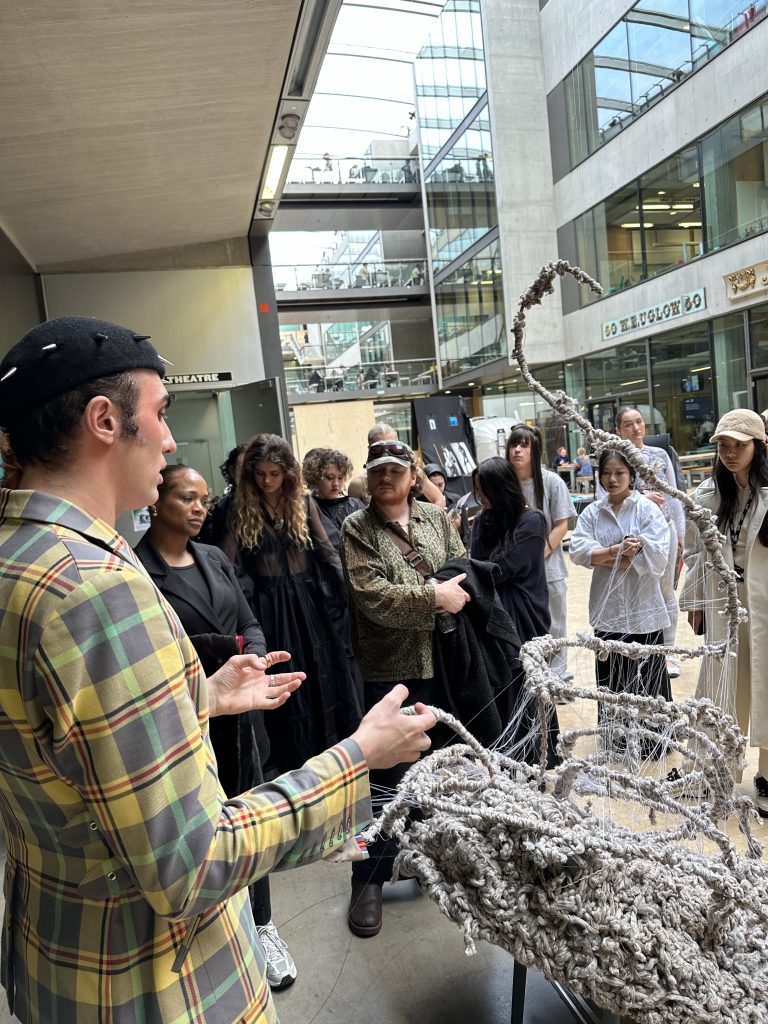
street area Kings Cross
Implementing a student led and designed curation and presentation space where students presented work in a chosen environment as an alternative to the standardised crit format of an individual presentation in front of their tutor and peer group, instead of a standard format of a crit, I arranged for students to exhibit work in various locations they chose around the Kings Cross building, in the street, the crossing, the bridges and photography studios. Students were given control of designing the exhibition spaces and how they wanted the work to be viewed. This gave them creative ownership of the crit day and they designed the format to be a group collective presentation to the student peer group and tutor team in a live exhibition format with each student curating their own space as an installation. Students presented their project outcomes and discussed their process to invited Industry professionals Charles Jeffrey, Reece Sweeney, Natalie Worgs/ gIRLS aBOUT pECKHAM and Paolina Russo, with CSM tutors Joshua Beaty and myself.
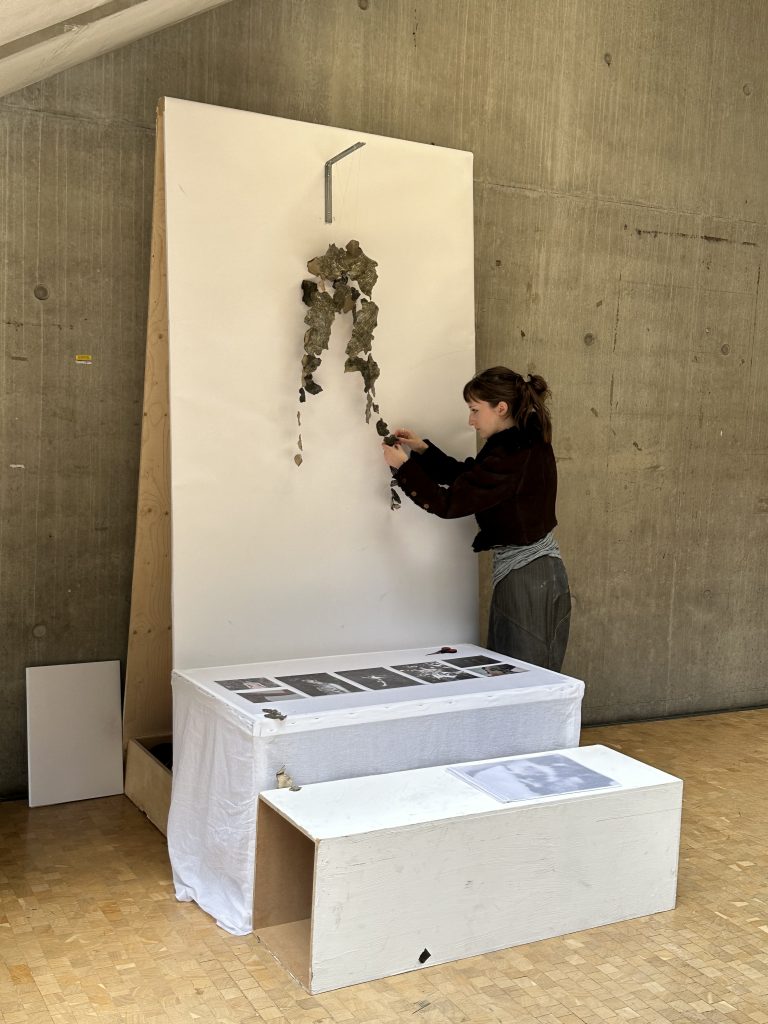
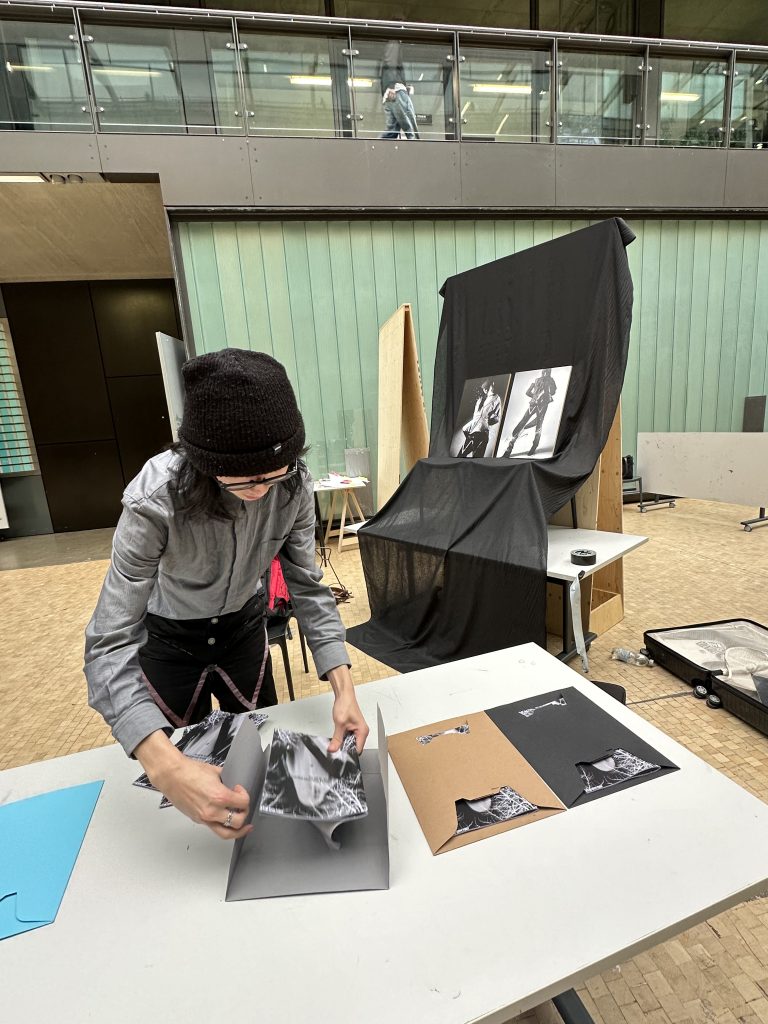
Students designed their own spaces and curated their work using printed images, video screens and their sculptural pieces and textiles.
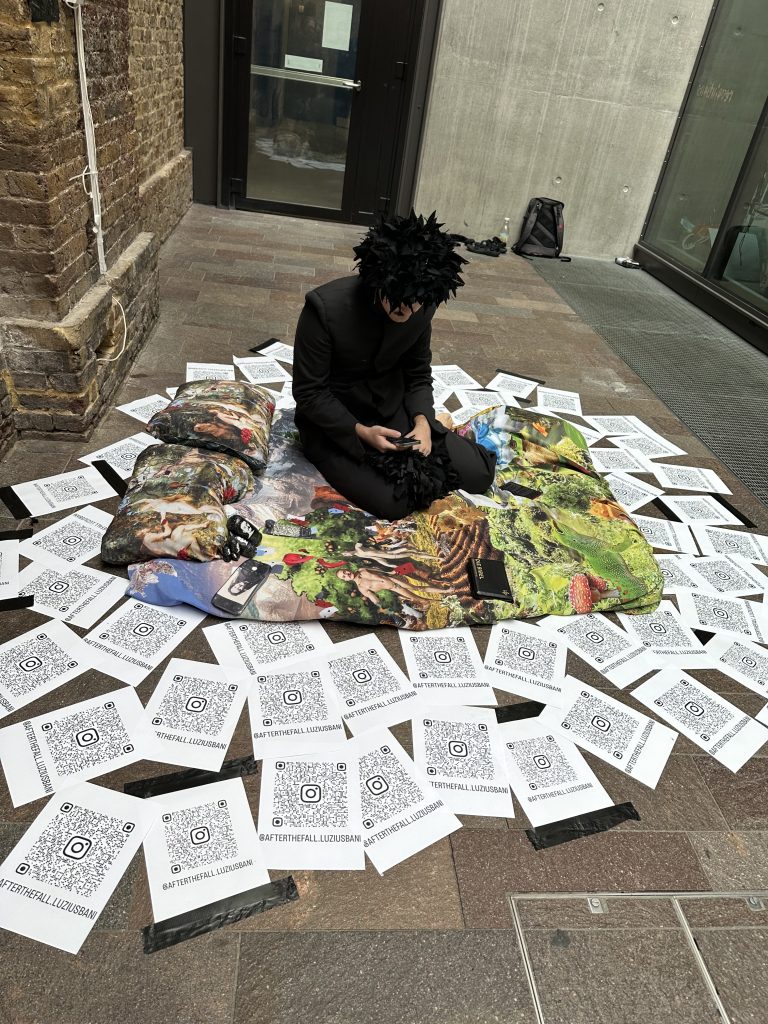
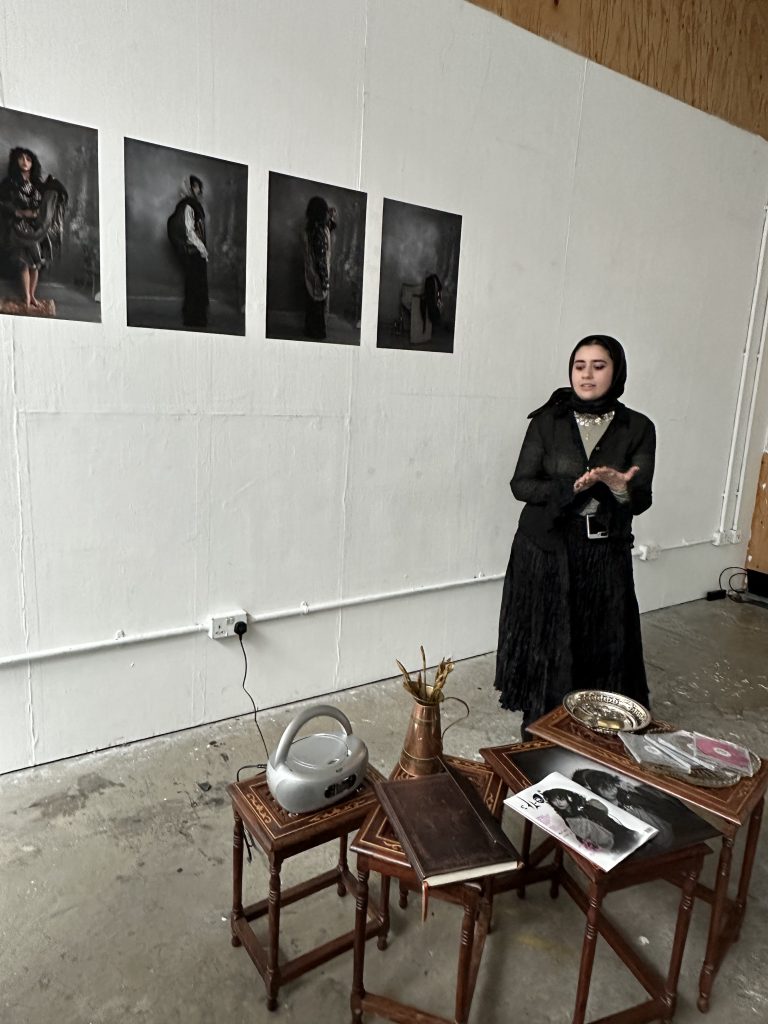
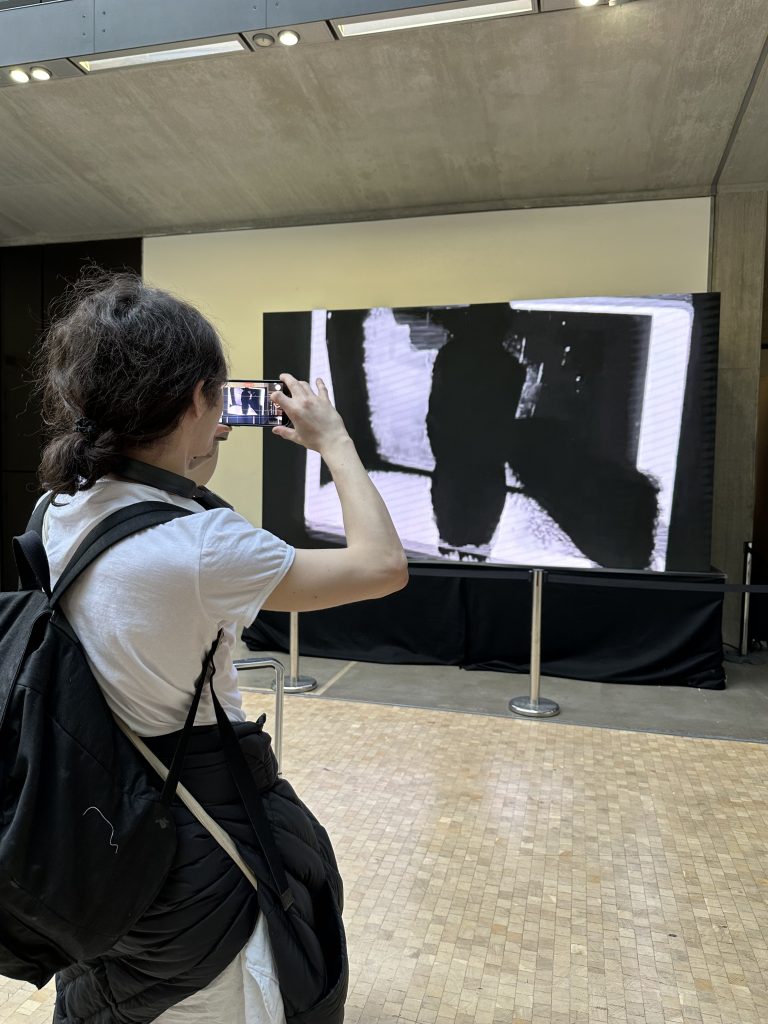
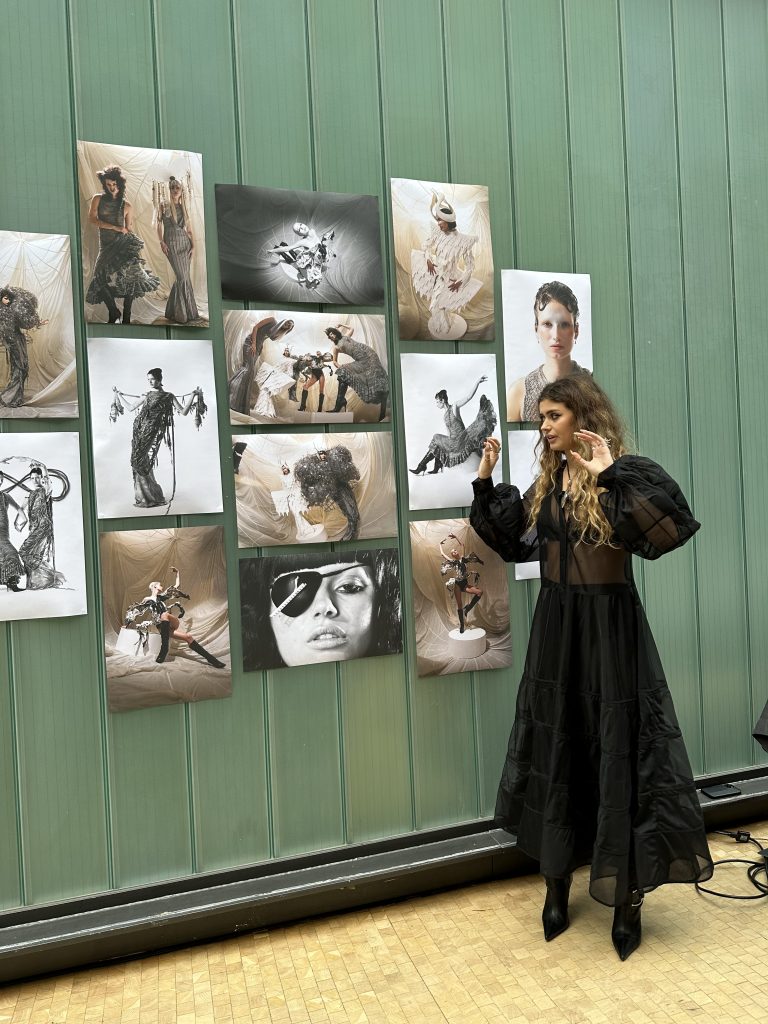
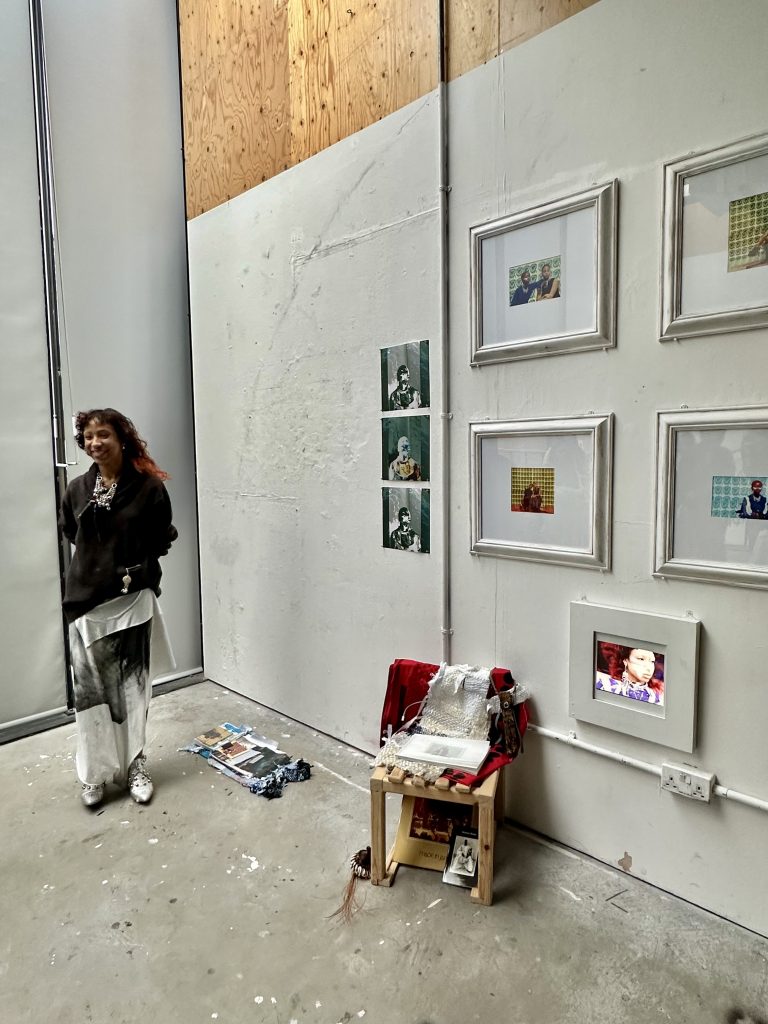
Students were highly animated and confident about presenting work in their own curated exhibition spaces which they had chosen themselves. It was a less intimidating and more celebratory event with students having the opportunity to choose one of the large open public access spaces or a smaller intimate room to exhibit their work.
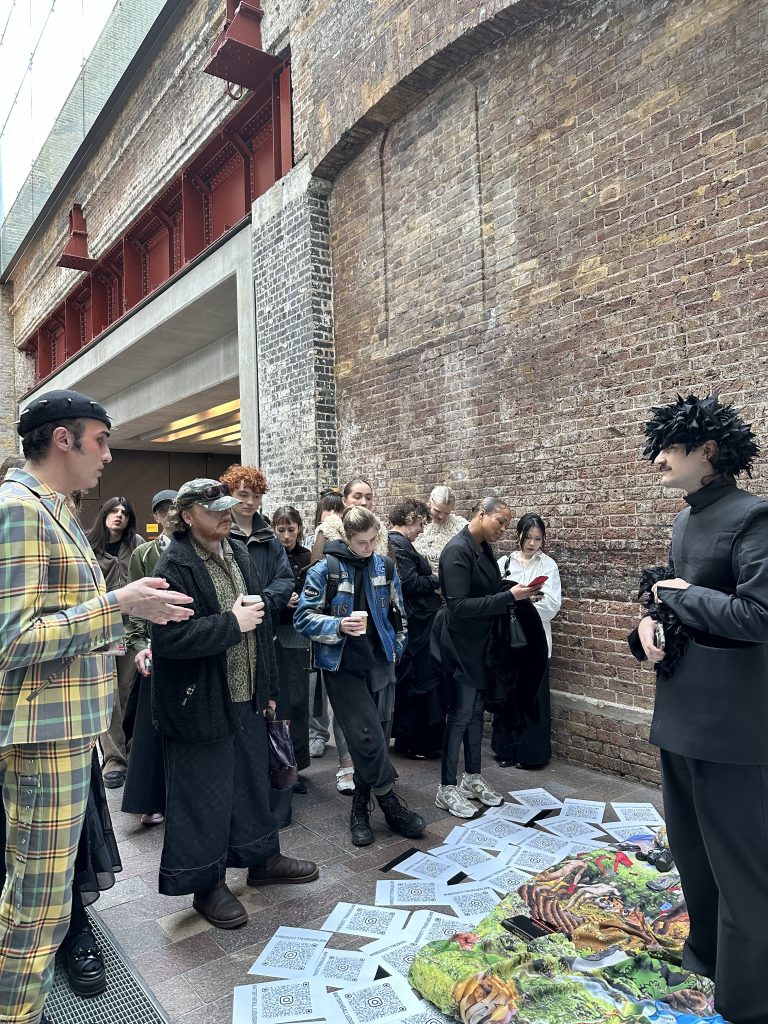
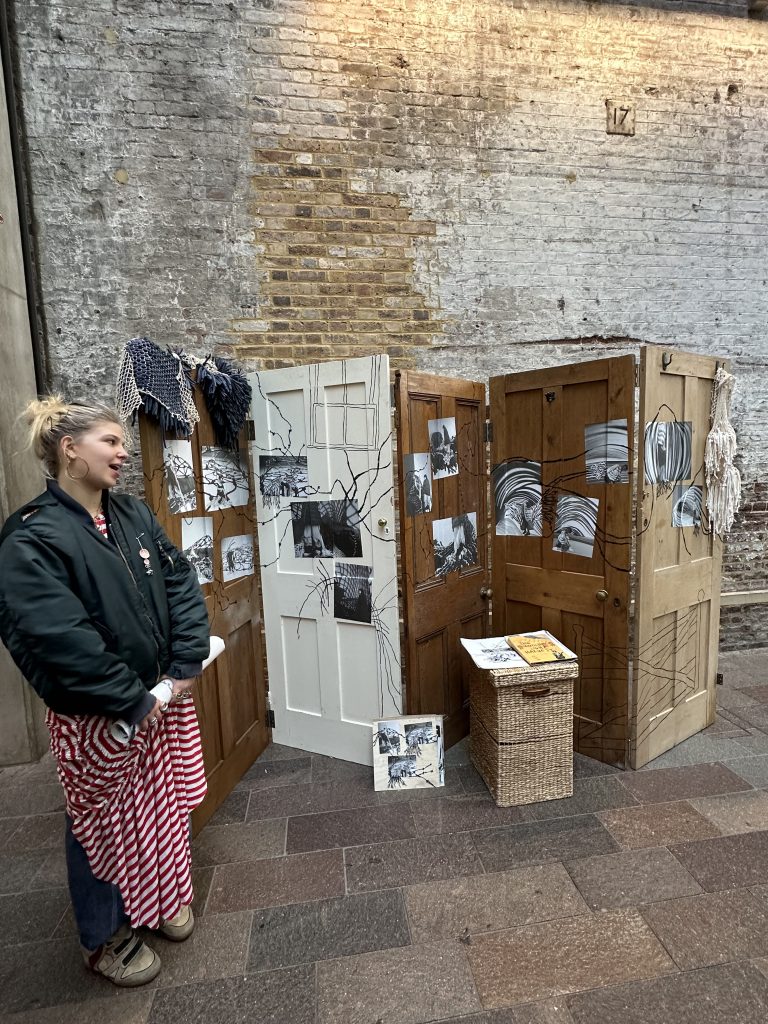
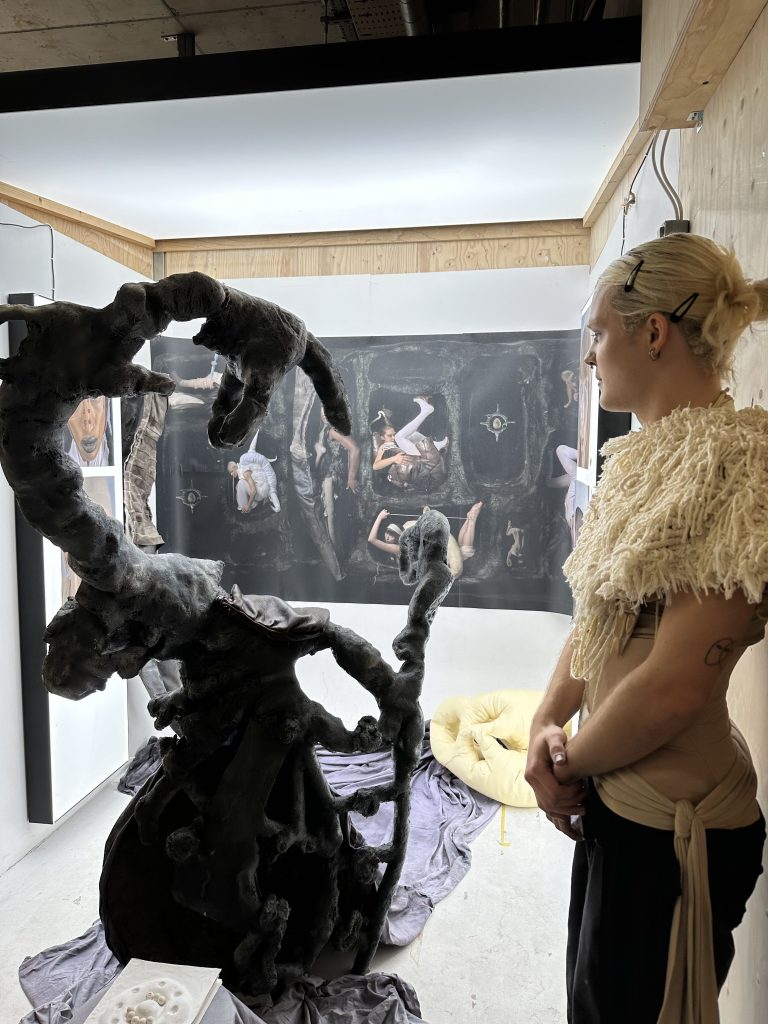
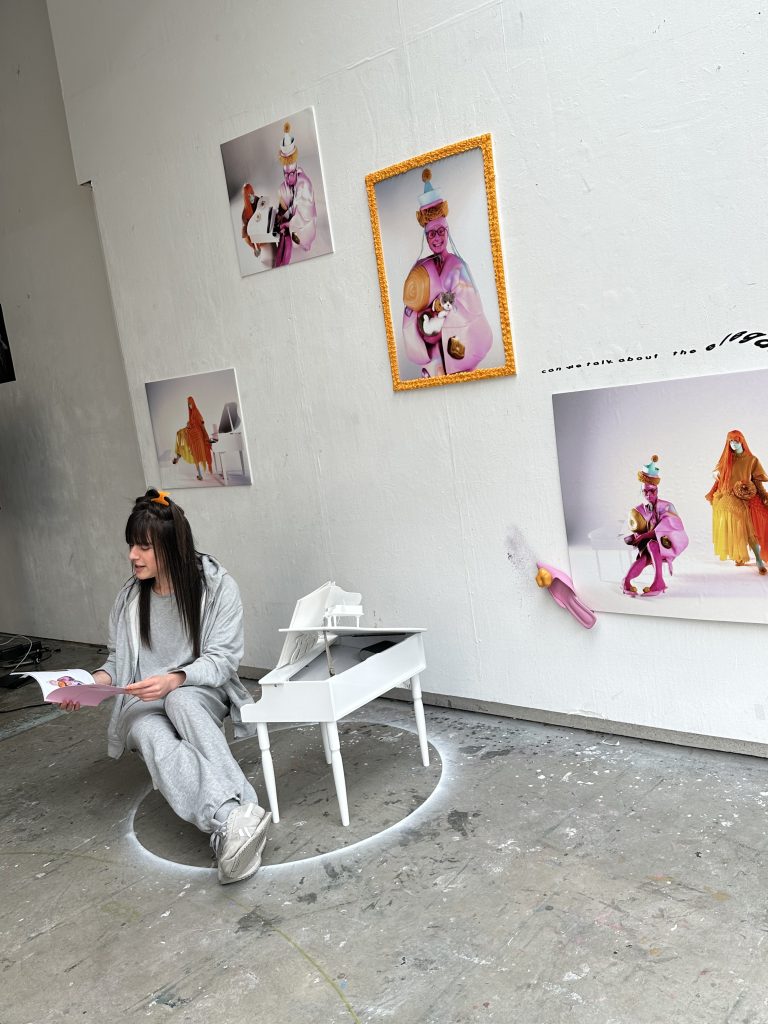
This was a really successful alternative to the standard crit format that students really found exciting, creative, less intimidating and stressful and it gave them an opportunity to take control of arranging and formatting the day and present their work in an environment they had chosen and designed, to invite their audience to view. The exhibitions attracted great interest in people from outside of the project who were excited to see the work laid out in an exhibition format.
I will definitely use this model again for future crits and presentations as the whole day was uplifting and inspirational for students and tutors. The general atmosphere was less intimidating and students supported each other and were all enthusiastic about viewing each other’s exhibition spaces. The feeling was very much that the group were a creative community who were a strong collective all working together.
DISABILITY
As well as my role of fashion design tutor and pathway leader, I have worked on the CSM Insights programme for several years focussing on widening participation and the empowering of young people from more deprived backgrounds and from minority groups to enable them to move into Higher Education.
During this experience I have worked with students who have wide ranging learning disabilities and experience many barriers in fully entering Higher Education programmes and courses. Students disabilities are often non physical and non visible and can often be more neuro diverse such as ADHD, dyspraxia, autism, dyslexia and this is combined with the intersections of complex combinations of personal commitments in caring for family members and constraints created by socio economic restrictions.
From my own personal point of view, I am from a low income family background, from the North of England, the first in my family to go to university and I am a single parent, so my own intersectionality and positionality has some close connections to some of the Insights students, which enables me to understand through my own lived experience, the complex barriers and constraints that can hold people back from self belief in the possibility of becoming a high achiever.
Following the study of the attainment gap within UAL student communities there is an obvious disparity between white and Asian/black/mixed race students, where white students are traditionally awarded higher levels of attainment. The contributing factors of this can begin even before a student embarks on a UAL BA course through the complex disadvantages they are experiencing within their positionality.

Students from more challenging backgrounds can often not want to declare a disability because they feel it might further disadvantage them. and students who have caring responsibilities for parents or siblings often do not want to disclose this even if it impacts negatively on their work output and standards of achievement, because they are in an environment where they are alongside students from more privileged or affluent backgrounds who have the appearance of being high achievers and having a confident outlook and strong self belief due to the educational advantages and learning opportunities they have experienced in their upbringing such as short courses, private tuition and access to high quality art and design teaching in their educational environments.
The video interview with Paralympian Ade Adepitan communicates a relevant viewpoint about the importance of giving people equal opportunities and realising that what makes people disabled are not the disabilities themselves but the barriers that are put in place by society which holds people back through systemic discrimination and therefore creates the disability.
Chay Brown, operations director and co founder of Transactual speaks passionately about the acceptance of intersecting identities and the importance of embracing all people in the wider community. Chay looks to actively dismantling the discrimination towards minority groups, promoting the need for inclusive environments and promoting empowerment for intersectional communities through changes in attitude towards minority groups and trans gender people and supporting accessibility in social venues. Accessible meaning accessibility for everyone, not just people with a disability.
We were asked to consider what barriers exist in our own context. In a high achieving and intense environment such as the Central Saint Martins fashion department, there are many barriers to overcome. Lack of studio space and overcrowding in the educational environment can create difficulties in expansive learning and high levels of anxiety for some neuro diverse students who find it highly problematic being in an intense social environment with many people in close proximity. Students who find this situation highly problematic if they struggle with a non physical or physical disability can request to work outside of the studio and create their own space and see tutors for regular tutorials for feedback and advice. Communicating through spoken language can create huge barriers especially with students who are non dominant English speakers or if English is not the first language.
Following viewing a film about Christine Sun Kim’s work and her artistic practice, it’s really inspiring to learn about how she integrates her personal lived experience of being deaf into how she approaches her work and uses her disability at the very centre of her creative process.
Christine’s artistic practice demonstrates valuable insights into her experience for educators engaging with students with hearing impairment or other physical disabilities that may limit their learning opportunities. The film explores Christine’s challenges with navigating how to communicate language from her early years, discovering the complex experience of her parents learning to speak English while also trying to understand and use sign language.
Language barriers and issues with ther complexities of verbal communication resonate with most students especially if English is not their first language and who are unfamiliar with the academic system and culture of the UK. Recognising and integrating the concept that creativity and the power of self expression serve as a universal form of non verbal communication, transcending any language spoken or written or cultural boundaries is a key component in art and design education.
Drawing inspiration from Christine Sun Kim’s film, there could by more awareness brought into the creative process using the powerful medium of visual communication, application of materiality and the use of colour, visual symbolism, surface design and sensory experiences in the fashion design process, focusing on fabrics and the intimacy of touch, sound and sight and how this impacts on the physical senses. Relating how these focused experiences shape our engagement with materiality could open up non verbal creative thinking about how students can be more aware of diverse needs inclusivity and accessibility.
If I were to continue this aspect of considering disabilities in future projects, I would direct students to watch Christine’s film to learn about a life’s journey for someone who overcame a disability through an intensely personal journey of artistic expression. It could open up a discussion drawing inspiration from Christine’s life experience. I could develop this by asking students to further explore the depth of varied and diverse sensory experiences created through exploring these narratives in the design process, recognising how these experiences shape our engagement with materiality it could challenge them to consider how they can be more aware of accessibility and inclusivity.
https://art21.org/watch/art-in-the-twenty-first-century/s11/christine-sun-kim-in-friends-strangers/
An example of how the consideration of disability into the creative fashion design process can be seen being put into educational practice in a recent BA year 2 fashion design project.
Team Project December 2023
2nd year BA Fashion students were given the challenge of designing a collection addressing the inequalities within the current fashion system.
Working in design teams, they explored the concept of fashion being accessible to all and focussing on consideration of physical and non physical disabilities when designing textiles and clothing.
The areas to be considered were —
What would be the ideal fashion system?
What is wrong with the current model and what needs to change?
Beginning with focussing on the four pillars of sustainability:
environmental
social
cultural
economic
Students produced a collection and promotional campaign, thinking about inclusivity/ diversity/ sustainability.
Aiming for a zero budget to allow for there to be parity across the cohort and no issues with any student struggling financially and only re-using existing materials which were donated by our industry partners, Re_Skinned and Glass Onion Clothing, each team presented a physical collection of 3 visual outcomes with at least one of the looks designed and produced for someone with a physical or non-physical disability or a diverse person.
Samanta Bullock, a world class tennis player and Paralympian athlete, now a global campaigner, speaker, activist and advocate for change, was one of the lead mentors on the project and presented students with her experience in being a wheelchair user and not being able to easily find directional and accessible fashion clothing, and how the lack of choice in fashion clothing she has experienced, which considered her disability led to her designing her own fashion range which is focussed on clothing that is considering the needs of people with physical disabilities and that is also considering creativity and modernity that is inclusive and accessible to all and integrating forward thinking in clothing design, is not just aimed at people with physical disabilities.
Fashion has been about the focus of the able-bodied for far too long, so this project gave students an insight into how to develop practical as well as creative solutions in clothing design for diverse people without compromising on creativity. Students also had invaluable information sessions with a member of the fashion staff team who offered their own personal insight into being an amputee and how this impacts on their physical needs when wearing items of clothing. This personal insight gave students the knowledge to consider how to design and create accessible clothing pieces that held powerful narratives within the fabrics and constructions.
As well as physical disabilities, students focussed on neuro diversity, visual impairment and people with complex non-physical disabilities which led to many ideas around incorporating the importance of touch, use of strategic colour placements, textures and construction concepts that provided detailing to help with anxiety and inability to focus in stressful situations, such as pockets with textured fabrics that calmed the wearer when they handled them, and also providing detailed protective elements where certain features such as hoods and pockets created safe spaces for the wearer to feel secure within the clothing piece itself.
To give an example, Sam explained that wheelchair users needed additional warmth for their legs, so students considered this when designing specific clothing designs with extra layers in the skirt. The practicalities and functionality were embedded into the creative design process so that there were no compromises in design.
1.Samanta Bullock modelling a look from the CSM Team project in the London Represents fashion show, 11th February 2024
2. CSM Team project, look promoting traditional craft and gender diversity in fashion design, London Represents Fashion Show 11th February 2024
3. CSM Team project, challenging barriers of age and disability. London Represents 11th February 2024
4. CSMTeam project, Textiles designed considering visual impairment of the wearer.
London Represents 11th February 2024
- Photographer Anna Orchard
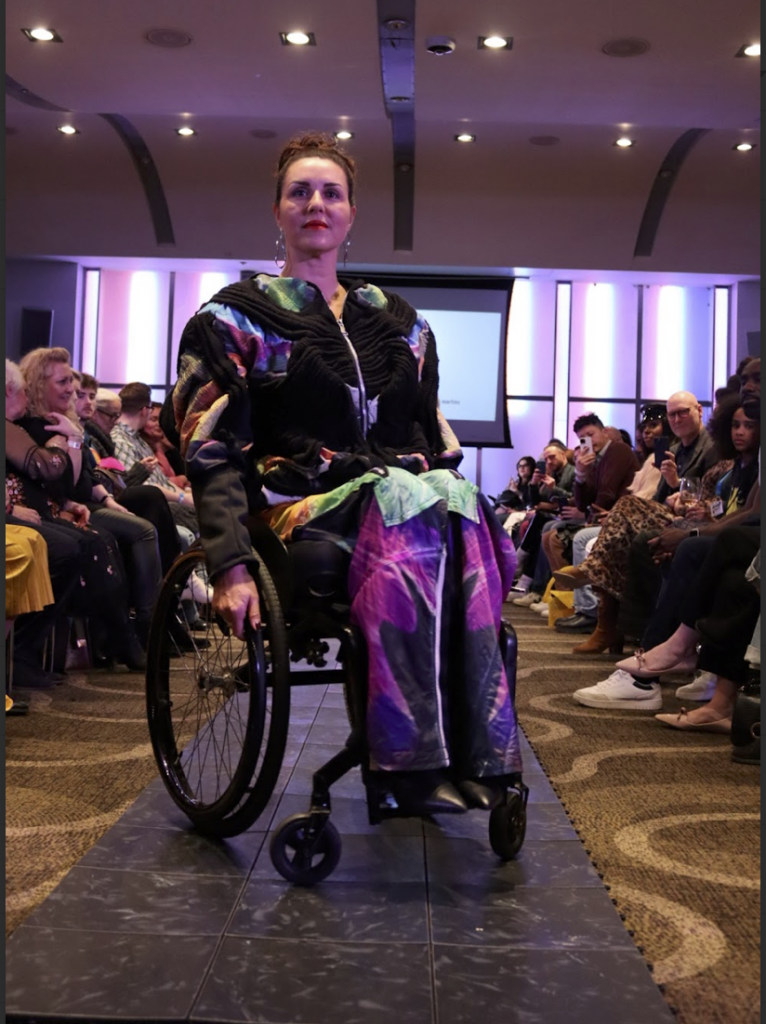
2.Photographer Ange Harper
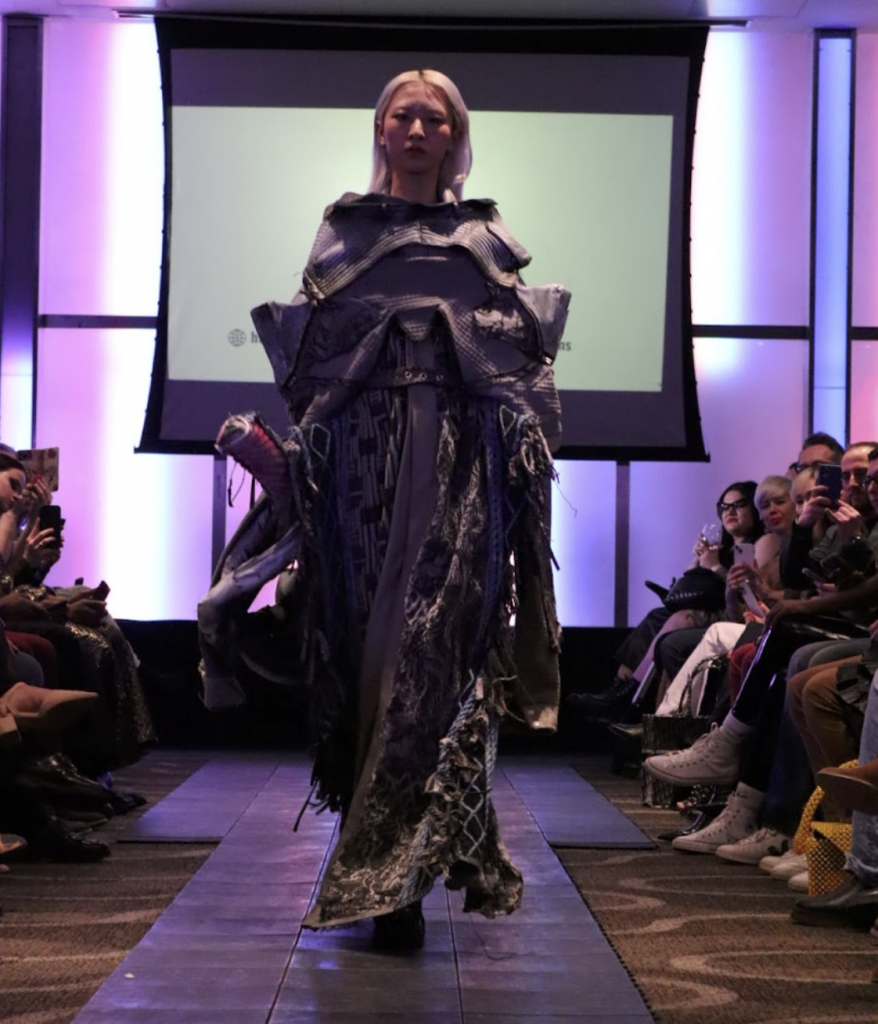
3. Photographer Anna Orchard
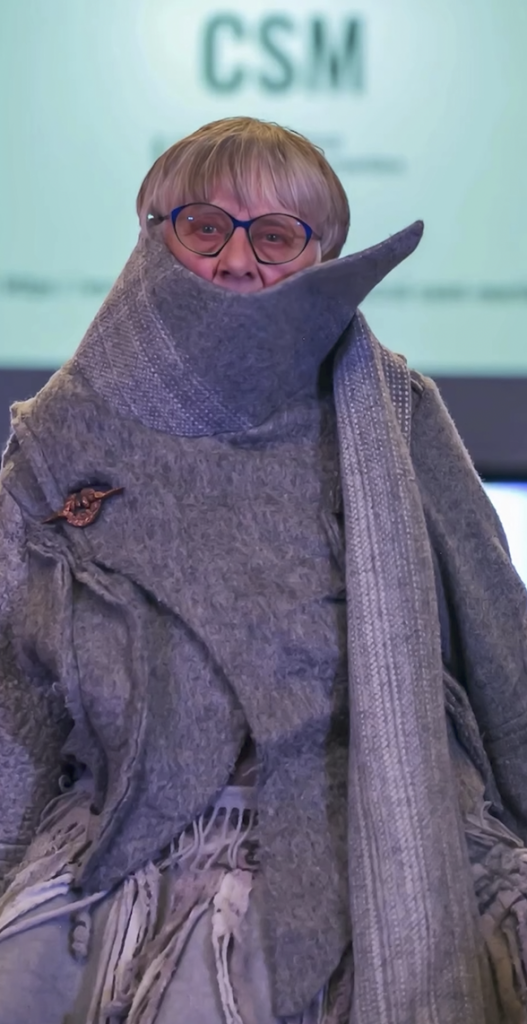
4. Photographer Anna Orchard.
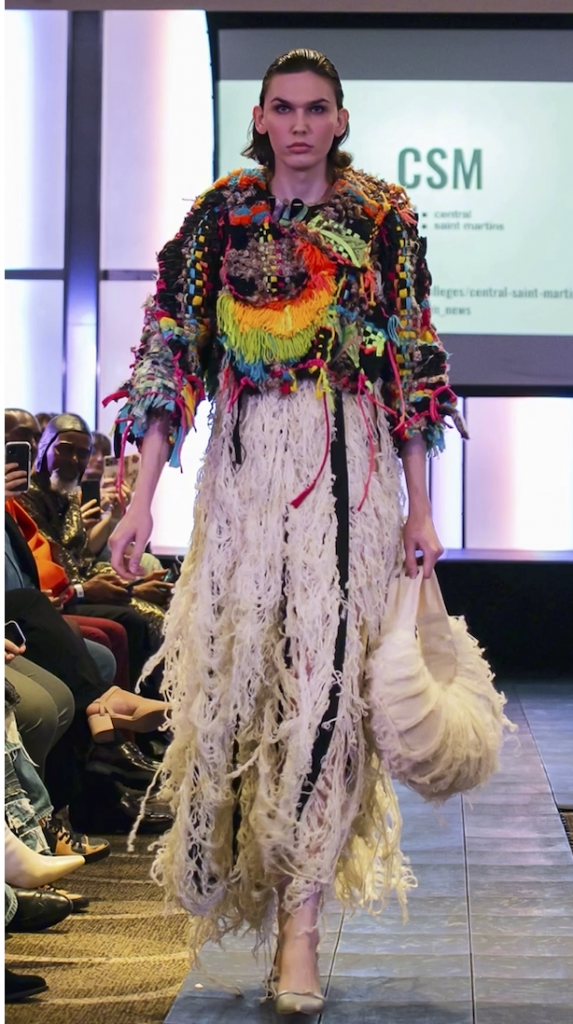
Accessible Fashion clothing for all is one of the driving forces behind Samanta’s campaign and she organises a fashion show during London Fashion Week called London represents which is a showcase of ethical fashion with designers showing inclusive collections using under-represented models and which reflect the need to diversify the face of fashion through disability, size, race, age and gender identity. Embedding this relevant awareness about these issues into the design process proved to be really inspiring and raised awareness about important issues within the industry that young creatives can address and build into their creative practice.
Comments and Observations about Disability blog by Kayalvizhi Jayavel
Stars:
The way the blog was structured as in introduction about you, and then introduction about the topic and connecting it with our own personal experience shows the reader centric approach and keeps the reader engaged and curious to know more.
The narrative about the attainment gap and your reflections around the discomfort of revealing the disability was apt
Though each video had various elements in them, you had captured the crux of what each interviewee wants to convey to the audience, which makes it nailing to the point.
Though there many common barriers like language, spotting some unique ones related to your fashion industry adds a different perspective which otherwise might not be visibly evident to the generic thinkers.
The importance of creativity and the power of self expression in the field of art and design is well brought out when you attempted to connect with the resource provided for us (Christine Sun Kim’s) and also suggesting it to the students was a proactive thought of motivation.
Documenting an example of demonstrating how disability can be approached in creative fashion (BA year 2 fashion design project) was engaging and a useful resource
Wishes:
I am not sure if there are hard restrictions on the word count, if so it seems more than 500 words
There are other statistical views available in our dashboard, which you may also consider addressing the topic of disability
Bullet points can be more eye-catching and emphasising when you had any points to propose or list
comments
13th May 2024 – Kayavizhil, It’s great to have your comments divided into stars and wishes – this gives really clear guidance about your opinions and suggestions for how the post could be structured in a more eye catching way and be better organised. I understand the word count is excessive but I did want to include the student project as I felt it was so unique and appropriate for this subject we are exploring.
FAITH
15th May 2024
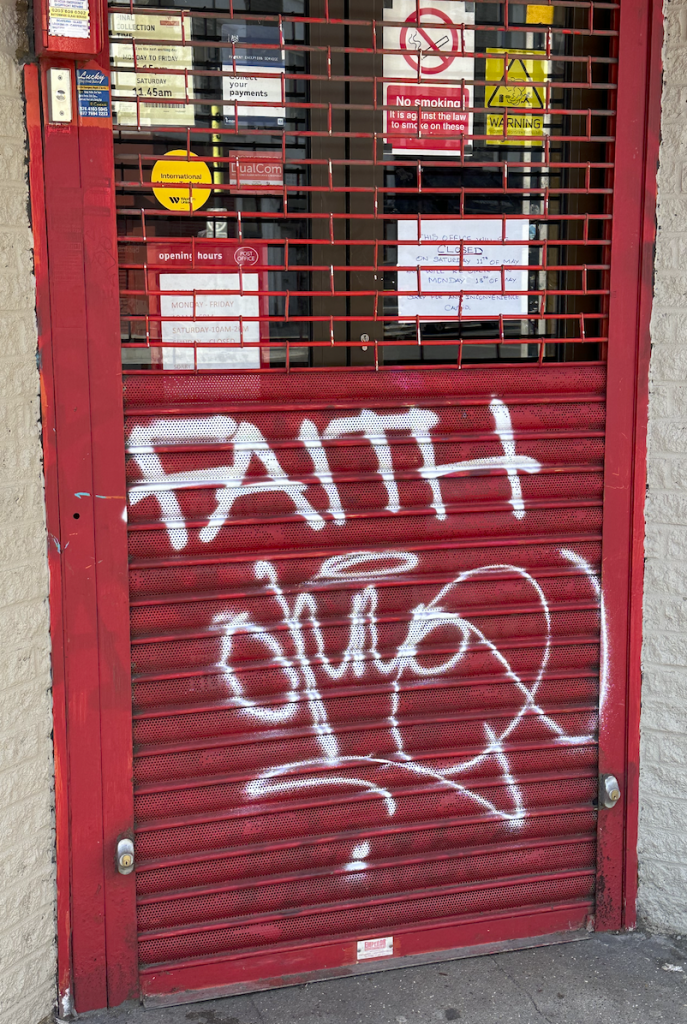
youtube.com/watch?v=lDYy0U7WtkM
Universities such as UAL are generally secular societies with an emphasis on the Christian religious calendar with particularly observance to Christmas and Easter when the main breaks in the term time are planned. Discussion and inclusion of multiculturalism into the curriculum and consideration of the diversity of the student cohort creates more diversity and interconnectivity within student groups.
In a creative environment where freedom of expression is paramount to the learning process, it is important to uphold a student’s right to express their points of view. Considering the current situation between Isreal and Gaza, opinion and points of view on religion within student groups and the educational institutions they belong to, are particularly heightened. Past CSM students who went on to produce Collections based on their religious backgrounds and their experience and observations around the effects on themselves and commentary on society in general can be shown in 2 examples. Hussein Chalayan’s Spring/ Summer 1998 progressive showcasing of western models wearing various adaptations of islamic dress, from a naked body wearing only a face covering to being fully covered in a long black flowing dress. This confronts commentary on both faith and religion and also the objectification of the female body. The relationship and differences between cultures is articulated through Chalayan’s upbringing as a Turkish Cypriot in Britain.
Another example can be seen in Patrick McDowell’s Catholic Fairytales which is imagined as taking place in a queer Vatican City, a magical world where everyone is accepted and celebrated for who they are.
The percentages of students who claim to belong to a religious faith within UAL is 30% with the main religions that students belong to being Christianity, Islam and Buddhism. These numbers are quite low within the student community but with recent events and protests occurring within the university buildings around the Isreal Gaza conflict, support for belonging to a faith and observing a religious belief system has become a really strong point of focus and there is increasingly a heightened awareness of engaging universities in the debate around associations and connections and how students are challenging and making their point of view in protesting to demonstrate around their disagreement of these associations.
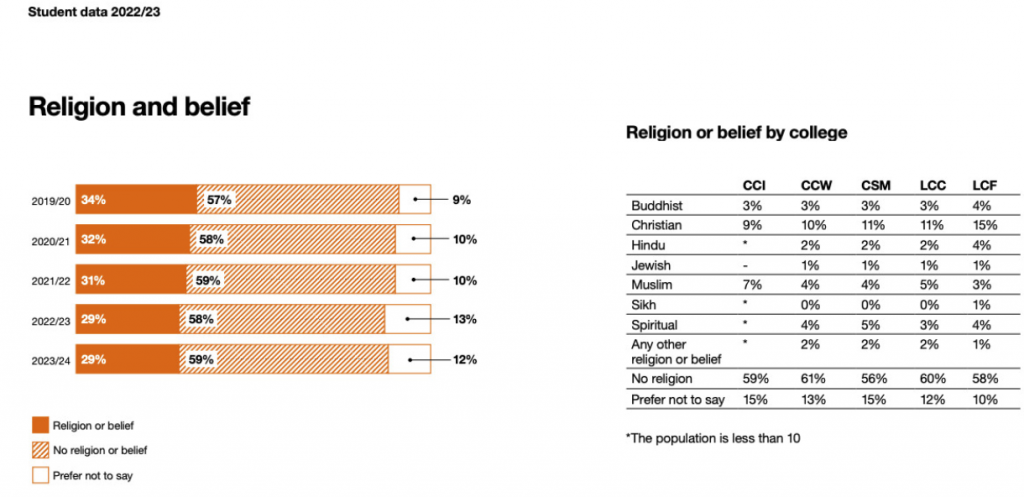
Simran Jeet Singh, Professor of religion
Professor Singh comments on discrimination on members of society who belong to certain faiths and how viewpoints on stereotypes can be challenged through communication and discussion. There are multiple ways of communicating diverse perspectives and in dealing with ways people navigate the nuances around faith through discussion and awareness. The university curriculum is largely based on Western origins, specifically in Fashion design within the pattern cutting of clothing. The identity of the U.K. and especially the university system, is usually described as multi-cultural and inclusive but there is a strong leaning in the methodologies of teaching that are rooted in European colonialism.
https://www.advance-he.ac.uk/knowledge-hub/religion-britain-challenges-higher-education
Having been a pupil at a Church of England school with very limited diversity in the school cohort, I have experienced the way the U.K. school system can impose a specific religion and cultural assumptions on the intake of the pupils and through the teachings. Universities can be more open to being multiculturalism societies and demand tolerance and active support for cultural differences.
The section titled, The Vaguely Christian U.K. explores how being British assumes belonging to a Christian religion and public expressions of owning a non christian faith and outwardly communicating belonging to a faith outside of Christianity through appearance, can be seen as ‘non British’. Considering that prominent religions claimed by the UAL student population include Islam, Hinduism, Buddhism prove that there is a strong multicultural representation, these faiths should all be inclusive of being British religions.
comments from Steven Johnson
I appreciate your emphasis on creative freedom at UAL; the ability for students to express their religious and cultural identities through their work is not just an educational benefit but also a form of personal and collective expression which enriches the students’ learning experience. Your examples of Hussein Chalayan and Patrick McDowell illustrate how deeply personal narratives can intersect with broader social commentaries through fashion.
Your post reminds me of Rahemur Rahman’s work, who is a lecturer at UAL that you may know already? He blends his Bangladeshi heritage with contemporary fashion. Rahman navigates the intersectionality of social identity and race, addressing Cultural Appropriation while celebrating his roots. His approach not only showcases the richness of his heritage but also challenges the fashion industry to respect and honour the cultures it draws from. Here is a link to an interesting piece about him on the V&A website: www.vam.ac.uk/articles/fashion-design-rahemur-rahman
Ensuring that varied viewpoints are heard and respected not only fosters a more inclusive campus environment but also prepares students to navigate and contribute to a globally connected world. The statistics on religious affiliation at UAL underscore the need for this inclusivity. While 30% of students identifying with a religion might seem low, the diversity within that percentage is significant. The representation of Christianity, Islam, Buddhism, and other faiths means a curriculum and campus culture that is genuinely inclusive and reflective of these varied perspectives.
Steve-thanks for your comments on the post –
I think your comments about Rahemur’s work and the statistics about religious affiliation at UAL are really valid. I think you pinpoint the importance of recognising and being aware of how a belonging to a religion or cultural heritage can significantly enrich and inform perspectives and approaches.
INTERVENTION TASK : initial proposal
INTERVENTION TASK Proposal / outline 13th May 2024
My positionality and life experience really influences my teaching practice and helps me to particularly understand students who experience barriers by coming from disadvantaged backgrounds. I’m from a low income family, from the North of England , a single parent and I have experienced how it feels to have been a young person with ambition, but because of my background, having low expectations placed upon me about the possibilities of what I could achieve in my life.
Students joining the BA Fashion course who are a Contextual applicant or who are from the UAL Insights widening participation programme often struggle when they start on BA Fashion courses at CSM. There is a marked number of students from this entry point, in my experience who leave the course in 1st year due to feelings of not being able to cope with the workload and the project expectations and they don’t feel able or confident in their skills to keep on track with the course and they also find it difficult to feel like they have a right to be there, or have equivalent talent and skills to match other students on the course who have experienced a more privileged upbringing.
Students on the Insights programme are selected as being the 1st person in their family to go to university and can be from disadvantaged backgrounds, low income families or from families with refugee status, and a high percentage experience barriers through learning difficulties or other invisible disabilities. Often a learning disability is undiagnosed or communicated, as students feel the need to not disclose any issues they may have in case it disadvantages them further.
My intervention idea is about is the possibility of there being a designated short course that I design in the summer break for Insights and Contextual students who have been offered places on the BA Fashion courses so that they are given preparatory tuition covering all the aspects that relate to the learning outcomes on projects they will be given in 1st year, specifically research, drawing, idea development, design process, 3D construction skills and presentation techniques before they begin their studies in September. Through this course, they will have the opportunity of receiving an enriching educational experience to help them with their creative and technical skills and confidence when they begin their BA studies.
It could run in a similar way to how currently the Insights short courses are delivered in the Summer schools where students work on a structure to cover the different aspects of the design process to gain portfolio building skills to apply for BA courses
I have proposed this idea to the other BA Fashion Pathway leaders who all agree that this would be a welcome intervention as they have similar experiences with contextual students feeling overwhelmed when they begin the course with insufficient support systems in place. As we are being asked to recruit applicants to create more diversity within the cohort and have to fulfil quotas for contextual and IMD quintile admissions, this means a higher proportion of contextual applicants will be offered places, so I feel this support will be really necessary going forward.
Other Fashion Pathway Leaders have said they would be happy to contribute towards the teaching and creative support of the students before they embark on the BA Fashion courses, as we all agree that there should be relevant support offered before students begin the BA course after they have been offered a place and not just at the portfolio preparation stages. I do not want to offer places and set up students to then fail once on the BA and I hope to build a relevant short course that can really support the initial stages transitioning on to BA studies.
references
https://www.arts.ac.uk/partnerships/outreach/applications-for-ual-insights
https://www.arts.ac.uk/study-at-ual/contextual-admissions
Reimagining-Conversations_FINAL
https://22047132.myblog-staging.arts.ac.uk/files/2024/05/Explore-Disability-Inclusion-Toolkit.pdf
RACE
From my viewpoint, writing a blog on Race feels incredibly inappropriate and could be seen at best as patronising and lacking in integrity. As a person seen to be from a position of privilege, I am unable to truly understand how the effects of racism affects someone. As an academic who selects the student cohort, I have undergone training in Fairness in Selection Students and Anti Racism training and there is much work produced on attempts at eliminating unconscious bias and how this can affect decisions. After watching a film of a talk by Shirley Ann Tate who speaks insightfully about the myths of racism and explodes the specific myth of unconscious bias as something that does not exist, it is interesting to hear this viewpoint and understand from someone’s personal experience that it is in her opinion, a made up term to create the idea that someone could be not consciously be racist but could still be racist without meaning it because of how they had developed their beliefs around opinions on social groups and social stereotyping from their upbringing. It highlights the inclusion and equality policies in place in universities as an attempt to increase student diversity and how to counteract the dominant whiteness of the course through recruitment.
Shirley Ann Tate discusses her experiences as a student, of racism and racist micro-aggressions that she encountered she and touches on how a hostile environment can lead to students who she describes as BPOC who want to leave in the first year of studies due to the difficulties of being in a minority and feeling what she describes as shame and anger that texture their experiences. The BPOC attainment gap statistically means that students drop out more than white students and if they finish their degree, they receive lower grades than their white counterparts even if they enrol with the same grades and are from the same social class. BPOC students can experience a cold climate created by institutional racism and unconscious bias. As there are official equality and inclusion policies in place, universities can be seen to be taking action on these issues, but this can also be seen as merely ticking boxes and not effectively tackling issues.
Shirley Ann Tate on Unconscious Bias: youtube.com/watch?v=lur3hjEHCsE and researchgate.net/publication/322868358_Whiteliness_and_institutional_racism_hiding_behind_unconscious_bias
In the CSM BA Fashion department, we have a designated academic who works programme wide on Race and the de-colonising of the curriculum, so there are positive actions being made in the structures and delivery of the course content. There have been several workshops and lectures on subjects such as cultural appropriation and also there has been direct input into project briefs, areas of research into more diverse ethnographic and less Eurocentric cultures, particularly in the cut and construction of clothing, and the encouragement of students to explore their own backgrounds and cultural uniqueness.
Shades Of Noir
Shades of Noir created by Aisha Richards, champions social justice pedagogy and and creates an educational resource and safe space for academics and students with a wealth of resources and campaigns.
- Curriculum design
- Pedagogies of social justice through representation
- Cultural currency
- Accessible knowledge, are the areas they work on to support the decolonisation and educate institutions.
- Highlighting the importance of these areas is essential.
Representation, Reclamation,Renumeration and Reparation Redistribution are the key points in their framework. This organisation is a highly relevant educational resource that confronts issues head on with integrity and offers interdisciplinary dialogue and debate that challenges and also supports anyone who interacts with their resources.
FACE
Fashion and the Arts Creating Equality
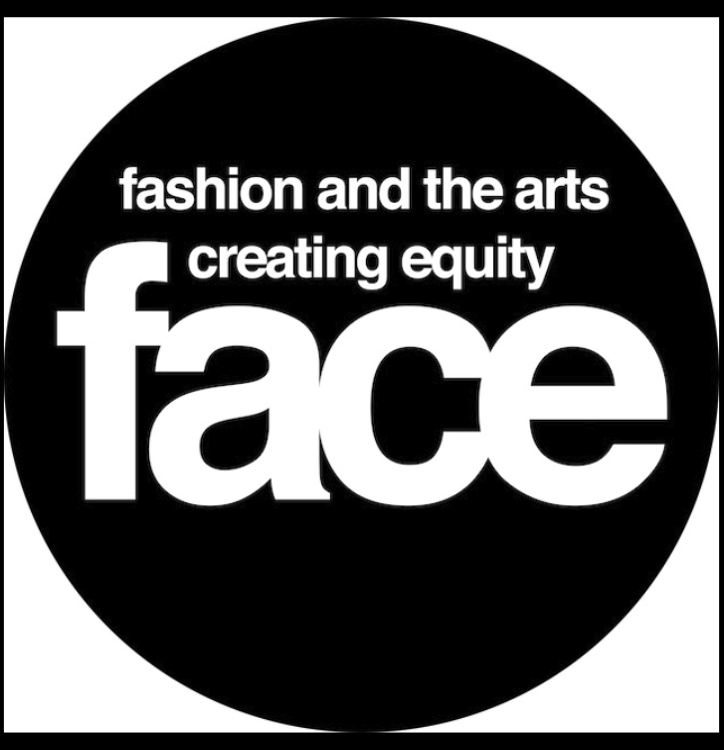
This organisation has strong beliefs in the intersection of the arts and academia is a powerful force for positive change.
Launched 2020, their goal is to embed culture and diverse perspectives into curriculums and seeks to demand acknowledgment of Black culture and creativity to history, society and to fashion. This is a growing community of activists and academics who are creating positive change and highlighting the lack of voice that was given to Black creatives. The recent Missing Thread exhibition focussed on untold stories of Black British Fashion and charted the landscape of Black British culture and the unique contribution it has made to the richness of British design history. Black creativity has had a profound influence on British culture but has been under-acknowledged. The exhibition’s aim was to seek to address this and showcase Black creativity through four themes – home, tailoring,performance and nightlife. The Missing Thread in particular spotlighted the work of Joe Casey-Hayford presenting the designer’s archive in an exhibition format for the first time.
https://www.somersethouse.org.uk/whats-on/the-missing-thread
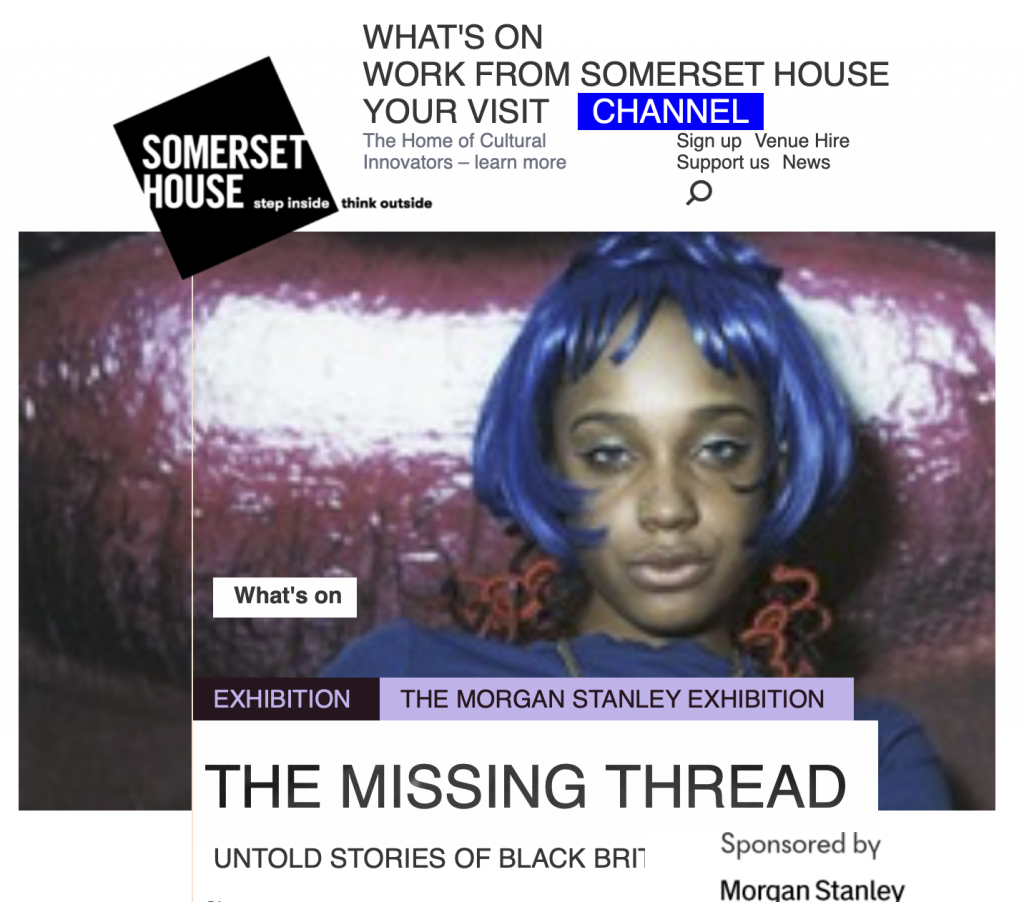
- Stephanie, I appreciated your post and reflections on race. I also appreciated how you started the post, acknowledging positionality and it made me think about whose voice is heard and how to give space for underrepresented voices. I was interested to learn that there is an academic on BA Fashion whose role is to work on race and decolonisation across the curriculum — that is interesting and I was wondering how much you and other lecturers get to meet with that person, how much time and space is there for dialogue and interaction and collaboration? Recently on BA Fine Art we have also been talking about issues around race — not only with regards to attainment gap but also around student awareness of race, diversity, inclusivity, understanding of positionality, and also how to approach these questions day to day in the studio and classroom.Reply
Stephanie Cooper says:5th July 2024 at 11:23 am EditHi Sabrina
we have a special tutor on race who works across the whole programme, so they can be asked to deliver lectures or be part of project delivery, tutorials. As they are across the whole fashion programme their time is limited, but they can be consulted on project briefs and any course content and be timetabled in to certain projects.Reply
Keira Bradshaw Greene says:5th July 2024 at 9:40 amEditRe Race blog: You give the insightful example (via Shirley Ann Tate) about BPOC students who want to leave in the first year of studies and who feel ‘shame and anger that texture their experiences’. These powerful and isolating experiences are not reflected in the unconscious bias training we undertake at UAL. In fact I find the unconscious bias quite strange as it is so un-relational, for a training that should be giving us tools to relate and learn from our assumptions. Shame and anger, difficult and transformative feelings, can be very instructive as they are such direct and visceral feelings, of course these kinds of feelings need to be held and discussed in a safe and well mediated environment, but alone via an online training is far from that.
That is fantastic that there is a CSM designated academic who works programme wide on Race and the de-colonising the curriculum. Something that really strikes me through undertaking this Unit is how much I could be drawing much more on the Stuart Hall Library and Iniva, advocating for social justice, which is on our doorstep at Chelsea. Thank you for this empowering post.ReplyStephanie Cooper says:5th July 2024 at 11:26 am EditHi Keira
thanks for your comments on your experience regarding unconscious bias, it’s good to know your thoughts and experience on this and to hear your plans to research more into archive around social justice.
INTERVENTION TASK
26/06/2024
PREPARING CONTEXTUAL ADMISSIONS STUDENTS FOR BA STUDIES
Following on from my experience in being on of the lead tutors on the CSM Insights programme, and more recently from my experience as Pathway Leader, BA Fashion Design:Communication, I have reflected on the difficulties contextual admissions experience when entering the BA course and this can lead to students experiencing feelings of despair and being overwhelmed which has led to them even leaving the courses.
From my own life experience coming from a contextual background, I can fully reflect on this and understand how my personal circumstances have shaped my teaching practice and my desire to create an enriching learning experience for all levels and backgrounds of students to create a fully inclusive environment where everyone is able to flourish.
Students joining the BA Fashion course who are a Contextual applicant or who are from the UAL Insights Widening Participation programme often struggle when they start on BA Fashion courses at CSM. There are a marked number of students from this entry point, in my experience who leave the course in first year due to feelings of not being able to cope with the workload and not being prepared for the levels of project expectations and they don’t feel able or confident in their skills to keep on track with the course and they because of this, they find it difficult to feel like they have a right to be there, or that they have equivalent talent and skills to match other students on the course who have experienced a more privileged educational upbringing.
We are asked each year to offer places to higher percentages of contextual admissions so that we are creating relevant inclusion and diversity in the cohort. If we are to increase the numbers of contextual admissions, there needs to be a support system in place to help students when they transition on to the BA, so they can feel confident in their abilities to freely learn. There is targeted support and regular tutorials to support the portfolio and application process for BA entry, but no support once the student is on the BA course. This needs to be addressed to create a better experience and higher rate of retention of contextual students.
Students on the Insights programme are selected as being the 1st person in their family to go to university and can be from disadvantaged backgrounds, low income families or from families with refugee status, and a high percentage can experience barriers through learning difficulties or other invisible disabilities. Often a learning disability is undiagnosed or not communicated, as students feel the need to not disclose any issues they may have in case it disadvantages them further, so issues only come to light when there is severe stress, failure of projects or a long period on non attendence.
My intervention plan is to introduce a designated short course that I design, to be available to contextual admission students and would take place during the summer break for Insights and Contextual students who have been already been offered places on the BA Fashion courses so that they are given essential preparatory tuition to help with skills and confidence, covering all the aspects that relate to the learning outcomes on projects they will be given in 1st year, specifically research, using the library, drawing, idea development, design process, 3D drape and construction skills and presentation techniques before they begin their studies in September. They would also be given information about all the facilities and workshops accessible to them such as Digital Media, Photography Studios and Digital Fabrication.
Through this course, they will have the opportunity of receiving an enriching educational experience to help them with their creative and technical skills and confidence when they begin their BA studies. This will also help to create a vital support group and network of likeminded students who they can rely on as mentors throughout their studies.
MENTORSHIP
I would request current BA students from contextual backgrounds to help on the course so that the connections are made at this point, forming a strong support network to continue when the new students commence their studies. This way, there is a supportive community formed that will continue throughout the length of the BA course.
COURSE STRUCTURE
The course structure could run in a similar way to how currently the UAL Insights short courses are delivered in the Summer schools where students work on an initial introduction course to cover the different aspects of the design process to gain knowledge about the courses on offer and then decide which route to choose when they begin the Insights programme in Autumn term when they work on tutorials for portfolio building skills before applying for BA courses.
The programme could be structured over a 3 week project which runs in the same way as the BA projects and ending in a group critique. This will give an experience of working on a full design project and also offer practice in presenting in a group crit, which many students will not have done before and which can be exceptionally intimidating for someone not used to this method of presenting work.
Week 1, Research
Introduction to the library, how to search for images, printing, starting to curate visual research to communicate a concept.
Week 2, Experimentation
Drawing, collage, initial 3D draping and exploring volumes in response to the research images.
Life drawing classes and creating fashion muse figures and faces to draw designs on.
Week 3 Presentation, Technical Developments, Critique
Presentation, curation, composition and portfolio building skills, design development, further 3D prototype creation, induction to using sewing machines, initial pattern cutting skills, technical approaches and learning how to sew fabrics to create an experimental prototype.
CASE STUDIES
I asked 2 students who recently graduated from the BA and who came from the Insights programme all the way through to finish the BA, about their reflections on their 1st year experiences.
Student experience on transition from Insights onto 1st year BA
Student 1
Can you tell me how you found the transition to BA
I found the transition difficult at first, I think compared to students who had done courses at CSM prior to BA Fashion such as Foundation In Art and Design, CSM short courses or Fashion Folio, they were more familiar with the self-directed way of teaching and what to expect in end of project critiques and were more confident discussing their work in front of a group.
What issues you faced
At the time of starting the course, I was one of few home students from a working class background and also I was 1 out 2 black students in my class. With this came issues of not always being able to relate to my peers, this can feel isolating as you try to fit in, I felt unsure how to integrate into other social groups.
Also at first, acknowledging I was not able to buy expensive fabric or pay for outside seamstress unlike some of my classmates made me feel at a disadvantage.
If you felt you needed more support
Yes, I definitely would have benefited from more support, once I began the course, whether it was more support tutorials or running a course prior to starting the BA for example helping with how to do your Summer Project before starting the course so you get a better idea of what to expect and to have experience in presenting and talking about my work in front of a group of people.
Also having a network of Insight students or mentors of different years giving advice/support before commencing the course and especially in the first few weeks, or even just more support of how to use the facilities in CSM to discover its full potential.
Student 2
Can you tell me how you found the transition to BA
At first, I was overwhelmed and hesitant, especially because of the other people on the course and the expectations of the work load set. It was like learning a new language to understand how everything worked on BA, as I didn’t really have examples of work expectancy or any mentors that were on board who had already completed their first year who I could talk to and ask questions.
What issues you faced
I didn’t know I had access to most of the university facilities in the beginning because I wasn’t made aware, and I wish I took advantage and had usage of everything available to me during first year. So, really emphasising on the facilities that CSM offers and doing more experimental workshops before commencing BA would’ve been very useful for Insight students like me.
I feel like because I was very hesitant and shy in talking to different tutors and students, having more classes and workshops as a whole before the beginning of the year would have brought a confident boost to a new Insight student, pushing them into talking to others in the same course/tutors as them. Building a strong relationship from an early stage.
If you felt you needed more support
It would’ve been more welcoming if there were additional support sessions before the BA course or support meetings I could attend, to get out my comfort zone and talk to more people and understand the expectancy of the course. Perhaps see more examples, see what opportunities and examples of creativity and what was possible.
WHY I DECIDED TO DO THIS
I have proposed this idea to the other BA Fashion Pathway leaders who all agree that this would be a welcome intervention as they have similar experiences with contextual students feeling overwhelmed when they begin the course with insufficient support systems in place. As we are being asked to recruit applicants to create more diversity within the cohort and have to fulfil quotas for contextual and IMD quintile admissions, this means a higher proportion of contextual applicants will be offered places, so I feel this support will be really necessary going forward.
In my exploration and study on this subject, I have considered my own experiences coming from a contextual background, and how this would have helped me in this situation. My reflection on this struggle I experienced has remained and it is still present within me in every situation.
As the recruiter of a course, I do not want to offer places to fill quotas and then set up students to then fail without the necessary support structure once they commence the BA and I hope to build a relevant short course and mentorship scheme that can really support the initial stages of BA studies.
This course I have proposed is for BA Fashion students, as this is my subject, but as a model, it would be able to be offered to other courses at UAL and create a strong support system, as a learning experience and mentorship programme across all courses, university wide.
I gave a talk to new Insights students on a CSM Summer School course, 1st July, as part of the CSM Summer School programme to give detailed information about my course, BA Fashion Design:Communication and show examples of work produced on the course, as a way of introducing the collaboration between the BA Fashion department and the Insights tutor team and students. The talk aimed to offer information about the diversity of the work produced and the personal approaches to individuality of student concept building and design processes.
INtENTIONS FOR MAKING THIS PLAN A REALITY
My intention is to present this proposal to Hywel Davis, Dean of CSM M School, Paul Glennon, Associate Dean of Insights, Susanna Rees, College Outreach Manager and Sarah Gresty, Course Leader,BA fashion design to propose that this plan becomes part of the CSM BA programme and offers this course to contextual applicants so they are supported from the start of their BA studies.
Other Fashion Pathway Leaders who I have communicated with about this plan have said they would be happy to contribute towards the teaching and creative support through being involved in the delivery of this course and working to support the students before they embark on the BA Fashion courses, as we all agree that there should be relevant support offered before students begin the BA course after they have been offered a place and not just at the portfolio preparation stages to prepare for the BA applications, with no support or mentorship beyond this.
References
https://www.arts.ac.uk/partnerships/outreach/applications-for-ual-insights
https://www.arts.ac.uk/study-at-ual/contextual-admissions
Reimagining-Conversations_FINAL
https://22047132.myblog-staging.arts.ac.uk/files/2024/05/Explore-Disability-Inclusion-Toolkit.pdf
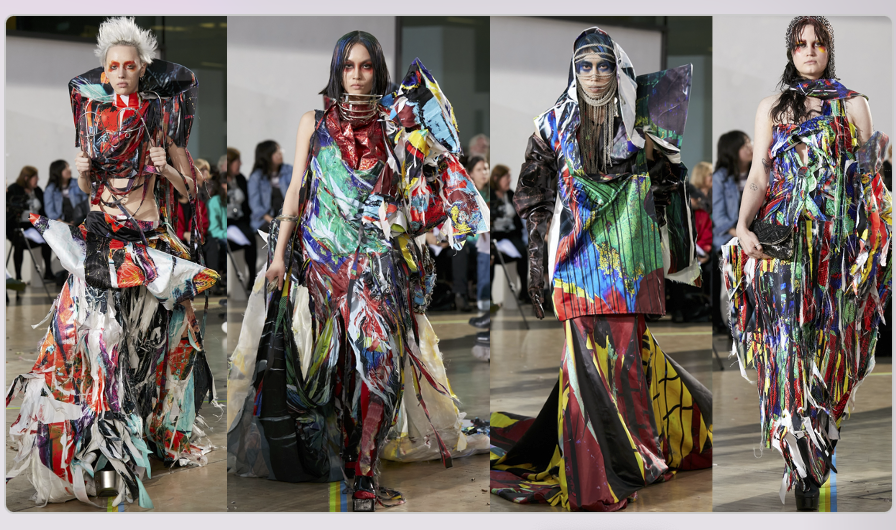
8 responses to “ACTION RESEARCH PROJECT”
Stephanie, I appreciated your post and reflections on race. I also appreciated how you started the post, acknowledging positionality and it made me think about whose voice is heard and how to give space for underrepresented voices. I was interested to learn that there is an academic on BA Fashion whose role is to work on race and decolonisation across the curriculum — that is interesting and I was wondering how much you and other lecturers get to meet with that person, how much time and space is there for dialogue and interaction and collaboration? Recently on BA Fine Art we have also been talking about issues around race — not only with regards to attainment gap but also around student awareness of race, diversity, inclusivity, understanding of positionality, and also how to approach these questions day to day in the studio and classroom.
Hi Sabrina
we have a special tutor on race who works across the whole programme, so they can be asked to deliver lectures or be part of project delivery, tutorials. As they are across the whole fashion programme their time is limited, but they can be consulted on project briefs and any course content and be timetabled in to certain projects.
Thanks Stephanie, that sounds great. Do you know how long you have had that role on the course?
Hi Sabrina – thanks for your comments – the lecturer is cross programme so they work on all the courses, so time is limited, but they do deliver workshops for tutors and lectures for students on certain issues. They are a fractional tutor so they are around a few days a week for a chat if that’s needed or just to run ideas or check project briefs and wording ! It makes a difference to have an expert especially in these areas where I don’t feel I have the experience to make certain decisions.
Re Race blog: You give the insightful example (via Shirley Ann Tate) about BPOC students who want to leave in the first year of studies and who feel ‘shame and anger that texture their experiences’. These powerful and isolating experiences are not reflected in the unconscious bias training we undertake at UAL. In fact I find the unconscious bias quite strange as it is so un-relational, for a training that should be giving us tools to relate and learn from our assumptions. Shame and anger, difficult and transformative feelings, can be very instructive as they are such direct and visceral feelings, of course these kinds of feelings need to be held and discussed in a safe and well mediated environment, but alone via an online training is far from that.
That is fantastic that there is a CSM designated academic who works programme wide on Race and the de-colonising the curriculum. Something that really strikes me through undertaking this Unit is how much I could be drawing much more on the Stuart Hall Library and Iniva, advocating for social justice, which is on our doorstep at Chelsea. Thank you for this empowering post.
Hi Keira
thanks for your comments on your experience regarding unconscious bias, it’s good to know your thoughts and experience on this and to hear your plans to research more into archive around social justice.
Race Blog
Hi Stephanie,
I very much enjoyed reading your blog post. I genuinely relate to your opening statement and have personally found this blog the most difficult one to write. I hope future generations will not feel the same, as they might be educated better from a young age and be able to discuss racism and anti-racism better than myself; relating back to your comment about Shirley Ann Tate’s views about the “myth of unconscious bias” and “a made up term to create the idea that someone could be not consciously be racist but could still be racist without meaning it because of how they had developed their beliefs around opinions on social groups and social stereotyping from their upbringing”.
Secondly, like Sabrina, I also appreciate the way you have started this blog by acknowledging your positionality – In hindsight, I should have done the same, In future, I will be careful to state my positionality honestly especially if my positionality might influence what I’m writing.
I was intrigued to hear you have a designated academic who works programme-wide on Race and the de-colonising of the curriculum at CSM BA Fashion department, I wonder how this came about and how you find working with this academic. It sounds like positive changes are happening over at CSM due to this academic, I would love to hear feedback from staff and students to see how they feel it’s enhancing their education. I also wonder if this is something LCF are planning on trialling.
Thank you for the introduction to Shades of Noir and Face, I have enjoyed reading about them and learning more about what they have to offer (SoN), I’m sure the curriculum design booklet will help me when planning sessions in future.
Hi Flur
It’s good to know that you’ve found some of the content useful and that you’ve been encouraged to state more about your own positionally. I think it’s important to acknowledge this. It’s good to know you feel the same about the difficulties in writing about race and sharing about your experience in the same difficulties in writing your blog.